










In a technologically advanced world, materialistic currency has become limited. Money and natural resources have been losing value to an infinite form of currency: our attention.
As attention gains value as social media and screen time usage increase, more people begin to feed into the “attention economy.” As a part of a Speaker Series on Apr. 16-17, SPA hosted Amalia Mayorga from the Strother School of Radical Attention based in Brooklyn, New York to teach the community about “attention activism” and creating an increasingly focused environment as an individual. The session, called “Cultivating Radical Attention,” was held in Bigelow with 60 attendees on the Tuesday night session and 25 on Wednesday morning.
The Speaker Series event began with Mayorga detailing Strother’s methods of attention activism and an attention economy.
“I see it as an economic system that relies on extracting our attention
to turn it into a commodity so that way, advertisers can make money off of selling us things,” she said. “That’s how big technology [companies] make money.”
mundane conversation prompt.
The goal of the second attention lab was to focus attention on the body. This lab began with participants closing their eyes and feeling their own hands thoroughly, and then transitioning to feeling their partner’s hands.
sophomore Paloma Gomez Whitney
Strother’s teachings of attention activism focus on hands-on learning through what Mayorga calls “attention labs.”
The first attention lab consisted of participants pairing up, assigning one person to be the first speaker while the other became the listener. The listener was prohibited from introducing new ideas and could only reflect back what the speaker mentioned. The goal of the lab was for participants to fully focus on the speaker despite a
After each lab, Mayorga invited participants to share their experience with the rest of the group, garnering mixed reactions from the majority parent attendees. For the few students that attended, Mayorga offered strategies to stay focused and limit contributions to the large corporations of the attention economy.
“My biggest takeaway was that ... being attentive to something shouldn’t be a chore,” sophomore Atari Ernst said. “I think that actually, if you pay attention to something, it can be really interesting.”
To wrap up the Spring Speaker Series session, Mayorga provided ideas and resources on how to reduce attention on technology throughout the day and recommended Strother’s new summer attention labs.
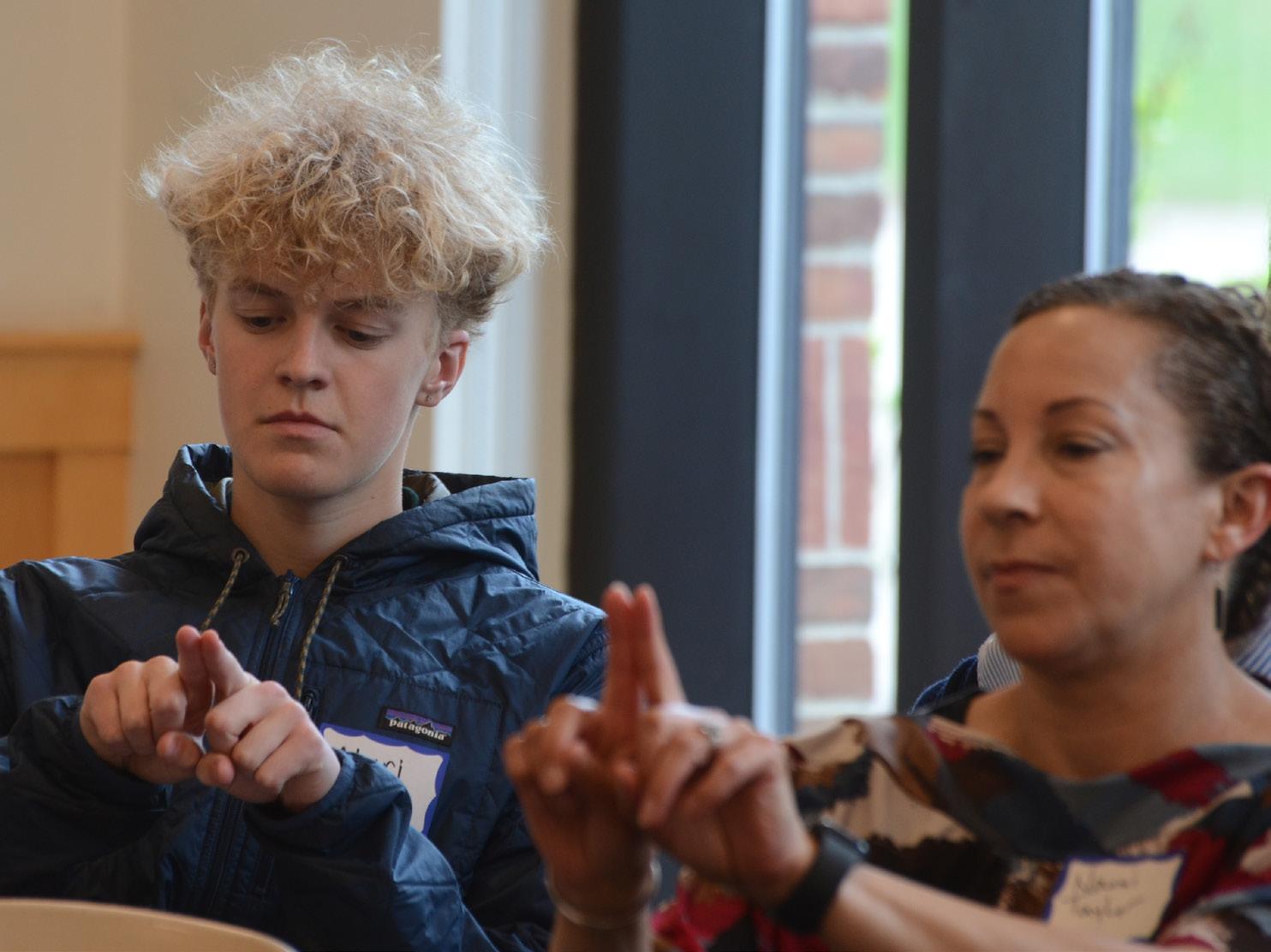
“I’m not the most attentive person because I get easily distracted but I’m hoping maybe in classes I can notice when my attention is shifting,” sophomore Paloma Gomez Whitney said.
For students looking for a more in-depth summer experience, The Strother School of Radical Attention is hosting two summer sessions for
rising seniors in New York City: session one runs from Jun. 24-28, and the second session is Aug. 19-23. More information is available on schoolofattention.org.
The Alumni/ae Council also hosted the Spring Speaker Series event “Instilling A Love of Art: A Conversation with Hazel Belvo and the Students She Inspired” on Apr. 11.

What would you want to see at a US Book Fest?
“
SPA THINKS [I would like] a non-fiction book sale.
junior Leila Mosenfelder

senior Anja Seifert “
It would be fun if we did a book swap.

The week of Apr. 15 was the Book Festival at the Randolph Campus, coinciding with National Library Week. But for those in the upper school, it wouldn’t be strange if they didn’t realize it.
Although the Middle School had a number of activities scheduled, including a Charlotte’s Web read-along and a schoolwide assembly, the high school’s once-vibrant, week-long celebration of books and literacy has disappeared without much of a trace.
US English teacher
Andrew Inchiosa is one of the US liaisons for Book Fest, along with fellow US English teacher Akie Kutsunai. Inchiosa explained that US-centric activities have been few and far between ever since he arrived at SPA in 2019.
“Last year, we were kind of part of the readaloud,” Inchiosa said, “but
I think because [MS and US] schedules are still a little different, and because most of the people attending are [from the] middle school, it became more of a middle school-centric thing,” he said.
According to MS English teacher and English Department Chair Carrie Clark, one important factor in Book Fest’s disappearance is a lack of institutional support.
With “the old version of [the Book Fest], there was a big committee of parents that really drove it,” Clark said. “I used to be a part of that as a Middle School rep. And then there was [US English teacher Randall] Findlay, who was part of that … He was really amazing and drove a lot from the Upper School side of things.”
The committee, which had about 10 members, took on the bulk of Book Fest planning. They coordinated the book sales, invited an author to speak,
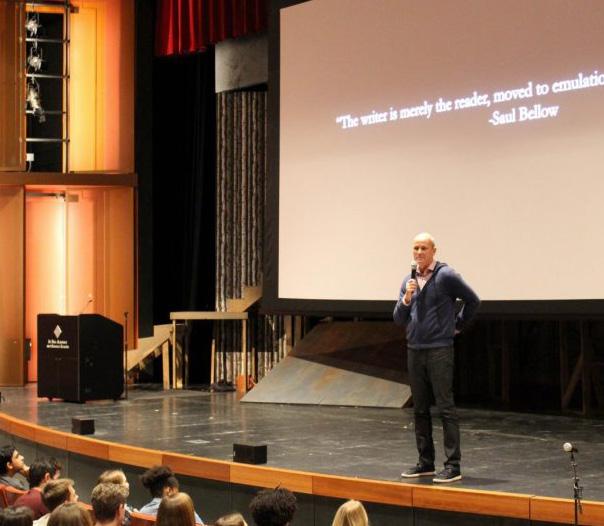
THE LAST US BOOK FEST WAS IN 2017. IN 2017, THE BOOK SALE WAS HELD AT COMMON GOOD BOOKS, AND 25% OF THE PROCEEDS WERE DONATED BACK TO SPA. FAST FACTS
and set up faculty-parent book clubs.
However, around 2018 the committee decided they wanted to move away from planning speaker commitments and book sales. An alternate vision for the Book Fest was never realized
after that. It also didn’t help that after COVID, the committee shrunk down to only one parent representative.
Nowadays, “the parents are trying to figure out how they want [Book Fest] to look,” Clark said. “They would love the faculty-parent book clubs, and they’d love to support whatever the teachers want to do. And the teachers have kind of been like, ‘How do we elevate books if we’re not having this big visual sale … how do we want this to be?’”
Another factor that impacted Book Fest planning was the schedule. The US has less time to dedicate to Book Fest than the MS. Plus, this year’s addition of a second round of narrative comments and student-led conferences may have limited the amount of time that teachers could spend on Book Fest work.
“I’m interested in what students would en-
joy, like if Book Fest in the upper school sounds fun [to them],” Inchiosa said.
Clark emphasized that she wants to have Book Fest planning start earlier in the year so that teachers and parents are under less of a time crunch to get it complete. She also suggested that students could give their input to shape the festival into something they’d be interested in taking part in.
“It will be cool if there’s a new vision that can make [Book Fest] a rich, engaging celebration throughout the Randolph Campus,” Clark said.
The last time The Rubicon reported on the US Book Fest was in 2017. It was an annual tradition to hear a published author speak to the school (2017’s guest was poet Michael Bazzett), continuously read a book aloud in 15-minute chunks, and attend both a used and new book sale.
After six years of planning, Family Discovery Night debuted at the Lower School in April 2023. Meant as an event for the SPA community to explore a variety of cultures, Discover Night was planned to launch in April 2020, however, COVID delayed the in-person gathering. Now, at long last, the popular Family Discover Night is coming to the Randolph Campus on May 3.
MS/US Intercultural Life Chair Naureen Qadri recalled last year’s event: “It was a super hit. It was the first time in so many years that the entire community came back to the school … everyone signed up.”
When Qadri took her position, she was excited to bring the event to the MS. Her hopes, however, expanded beyond that.
“We have a lot of enthusiasm from the Middle School parents because parents don’t really get an opportunity to volunteer that much once their kids reach middle school and Upper School,” she said.
Many popular events from last year are set to return, including backgammon, cricket, henna, Arabic calligraphy, and more.
A key difference, however, is that the mini-activity groups will be primarily student-run this year, a change due to the event’s relocation to the Middle School.
“I heard from some of the people in the administration and some of the other parents that the middle schoolers want to be more independent, and they want to do the minis by themselves,” she said.
From 5:15-6:00 p.m., all families are welcome to the Huss Auditorium for African Dance with the Tiyumba Drum and Dance Company, a group returning from last year.
Intercultural Life Program Specialist Alexis Irish sent a sign-up sheet to upper school students asking for their interest in representing their culture by leading an activity session.
Qadri noted the initial interest in the event was not as high in the community of older students; still, several students have signed up to be volunteers, helping out as floaters.

“I decided to volunteer at Discovery Night because one of my friends reached out about doing it together, and I thought it sounded like both a fun way to spend time with a friend and also a way to participate in the school community that was interesting to me,” sophomore Frances Matthews said.
“I expect this event will be informational and engaging,” sophomore Minh Tran said. “MS Family [Discovery] Night and similar events are a great way to build community, as they allow you to learn more about and connect with classmates,” he added.
Qadri hopes that the event will incorporate everyone on the Randolph Campus in the future.
“My vision is that maybe next year, we can have a combined event [with Middle and Upper Schoolers], and we can transition so that kids can use their leadership skills and share their culture [and] heritage,” Qadri said.
The Parent Association hopes that encouraging all community members to participate would make the event a meaningful and fun learning experience.
“That’s what we saw in the Lower School,” Qadri said. “[Discovery Night] brought the community together, and kids learned a lot of new things about different cultures.”
As the organizer, Qadri recalled being pleasantly surprised by the new information she learned and was thrilled to watch her son take pride in his culture when his classmates came to school wearing henna.
“I’m hoping that [Discovery Night] becomes a part of SPA because it really impacts the kids in a positive way,” she said.
Sophomore volunteer Taryn Karasti is likewise optimistic about the event’s impact.
“I think the event will be really fun. I imagine kids finding things that they’re truly interested in, which makes me happy to see,” Karasti said.
The SignUp Genius for Family Discovery Night is live; middle school students and families can sign up to attend, and upper school students can sign up to lead a session.

“And the fact that there is something threatening that is kind of disturbing.”
Similarly, sophomore Evan Morris believes the Minnesota Voting Rights Act will fortify voters’ rights, as long as it’s written properly. “I would want to be careful with making sure that all the fine details are streamlined … If it really is doing what it says, I think that could be a great way to help address some of the systemic issues that we have.”
Other protections, such as ensuring high schoolers the ability to pre-register to vote, were approved alongside the act in the Senate vote.
On Apr. 18, the Minnesota Senate passed the Omnibus Elections Bill in a 35-32 vote, which included a Minnesota Voting Rights Act. Sen. Jim Carlson (DFL-Eagan) authored the bill, explaining that it “protects and expands the freedom to vote for people across the state, encourages voter participation, and prevents harassment of election workers.”
Minnesota had the highest voter turnout rate in the country in the
2016, 2018, and 2020 elections; according to Minnesota Secretary of State Steve Simon’s website, 79.96% of eligible voters voted in the 2020 general election.
Despite these high levels of voter participation, a November 2023 ruling by the Eighth Circuit of the U.S. Court of Appeals has made it more difficult for people to ensure their right to vote. That’s where the Minnesota Voting Rights Act comes in.
The Appeals Court’s decision removed the right for citizens to sue against discriminatory
policies under Section 2 of the federal Voting Rights Act, which prohibits voting standards against a citizen’s race. The Minnesota Voting Rights Act will combat this decision by allowing citizens to protect their voting rights and sue against discriminatory voting practices within the state.
“I think the [Appeals Court] ruling is very, very controversial, but voting rights should be very much a guaranteed right for any citizen of the United States,” junior Cerena Karmaliani said.
“I think that in Minnesota, there’s not a problem yet,” US History teacher Jon Peterson said. “But it sounds like what the legislature is doing is saying that this could be a problem, and we want to get ahead of it ... so having a stronger law … would make a lot of sense.”
Next, the bill will return to the House of Representatives to approve the changes, and then Gov. Tim Walz will make the final decision.
St. Paul resident and sophomore Hazel McCarthy has seen copper wires disappearing from street lamps. “Copper wires are getting stolen, and there’s twenty dollars of copper in each lamp,” she said. Hundreds of street lamps are missing panels, with green and black wires exposed at their base. “It costs like one or two thousand dollars to repair, and it’s also a big safety issue because you can’t see when it’s dark out anymore,” McCarthy said. “They’re [currently] testing out different access panels at the top of the lights, but it would cost a lot to switch them all,” she said. Minnesota Governor Tim Walz has expressed his support for legislation aimed to minimize copper wire theft.
This March, Minnesota state senator Mary Kunesh (DFL-New Brighton) and Representative Aisha Gomez (DFL-Minneapolis), introduced The White Earth State Forest Land Transfer Act, which seeks to return 155,000 acres of state-owned land to the White Earth Nation by Aug. 1, 2029. This bill aims to promote tribal stewardship over ancestral territories lost by the White Earth Band of Minnesota’s Chippewa tribe. Kunesh, the first Indigenous woman to serve in Minnesota’s state senate, hopes it will acknowledge their sovereignty and provide the tribe the right to manage lands as they wish.
PETER OSTREM THE RUBICON emissions of 3 million cars. According to the Department of Energy in March, this is the largest investment in industrial decarbonization in American history.
At the end of March, a roughly $7 billion dollar project was announced by the Biden-Harris administration. According to a White House fact sheet, the project includes 33 industrial projects in over 20 states.
The goal of the investment is to lower the carbon emission rates in carbon-intensive industries. There are numerous positive side-effects of the project, including supporting good-paying union jobs, strengthening the nation’s manufacturing industry, and revitalizing industrial communities.
The investment focuses on decarbonizing the highest emitting industries, including the production of aluminum and other metals, cement, concrete, chemicals, and refining. The project is expected to reduce more than 14 million metric tons of carbon dioxide each year, equivalent to
I
Industrial production takes third in the United States’ emissions.

Although this project is a huge step forward in decarbonizing the industrial system and lowering the number of fossil fuels, there has been some criticism about how long it took the Biden administration and the Department of Energy to advance these plans. “I think he definitely put it off, but it also could be hard to convince the businesses to get on
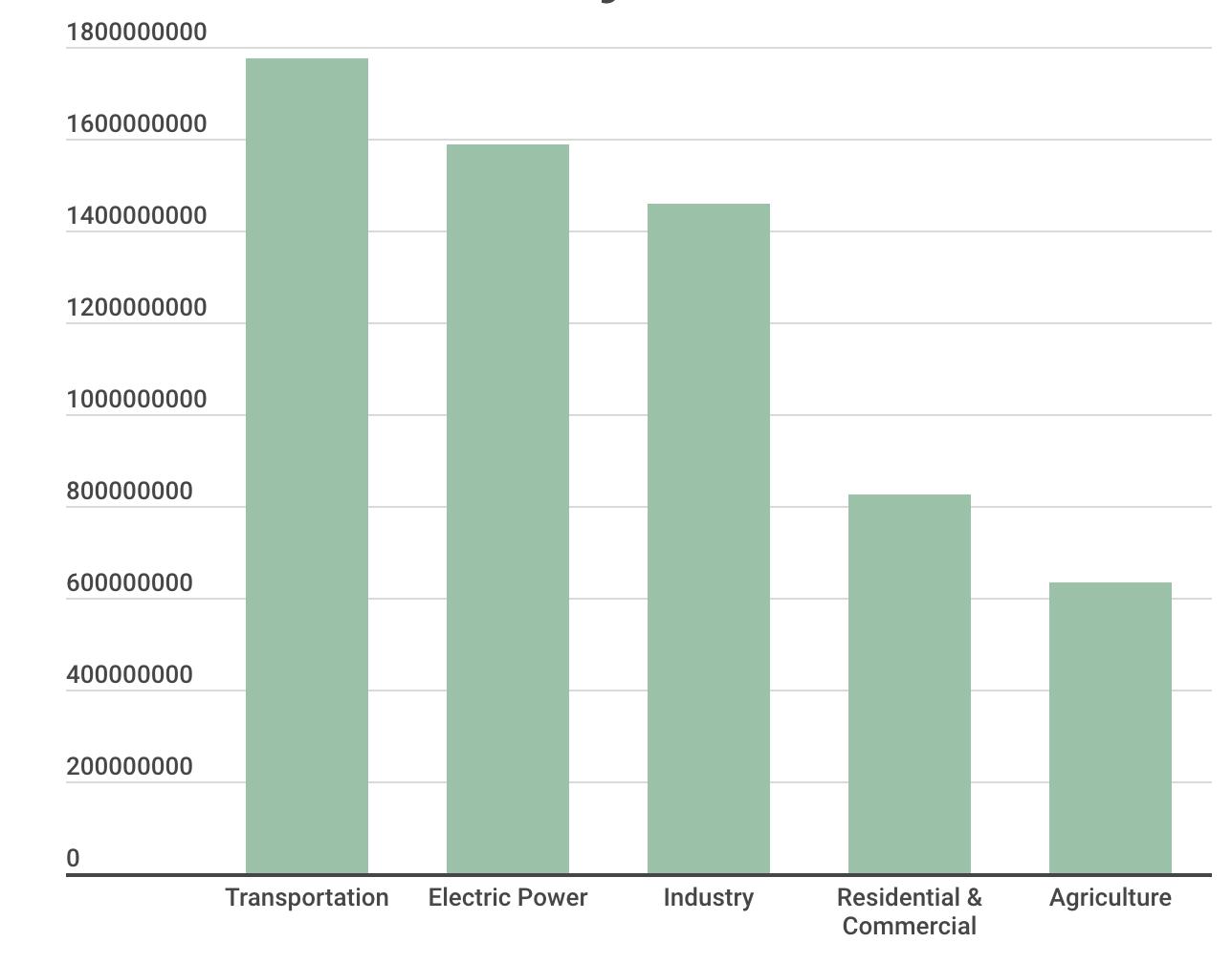
INFOGRAPHIC: Olympia Wolff
INFORMATION: United States Environmental Protection Agency
board with the project, because it probably is less cost-effective,” junior Lucas Granja said.
Making this investment now, during Biden’s re-election campaign,
instead of earlier in his presidency, could be a strategic move to increase his chances of being reelected.
Freshman January Cook sees the recent
change as aspirational: “I think it’s great that they’re doing this project but I think their proposed goal of cutting all carbon emissions by 2050 is too ambitious and un-
realistic,” Cook said. Cook believes that we should follow a similar anti-carbon plan to some European countries, like Sweden.
“Everyone takes buses and trains or walks, and very few people drive. I do think that would be hard to instill in America though,” Cook added. “I like their ideas, but I disagree with how it’s being done.”
“The next steps after this would be to try to completely eliminate fossil fuel emissions from the large-scale industries. Obviously, that would be a lot of work and money but I think that should be the ultimate goal,” Granja added.
The Department of Energy and the Biden administration have been working towards other similar projects, such as a new decarbonization plan for homes and buildings, aiming to reduce carbon emissions by 90% in 2050.
Claire Kim Orion Kim
Georgia Ross
Sonia Kharbanda
Olympia Wolff
Eliza Farley
Johanna Pierach
Annie Zhang
Amanda Hsu
Clara Ann Bagnoli
Juan Miguel Adams
Peter Ostrem
Annika Kim
McKinley Garner
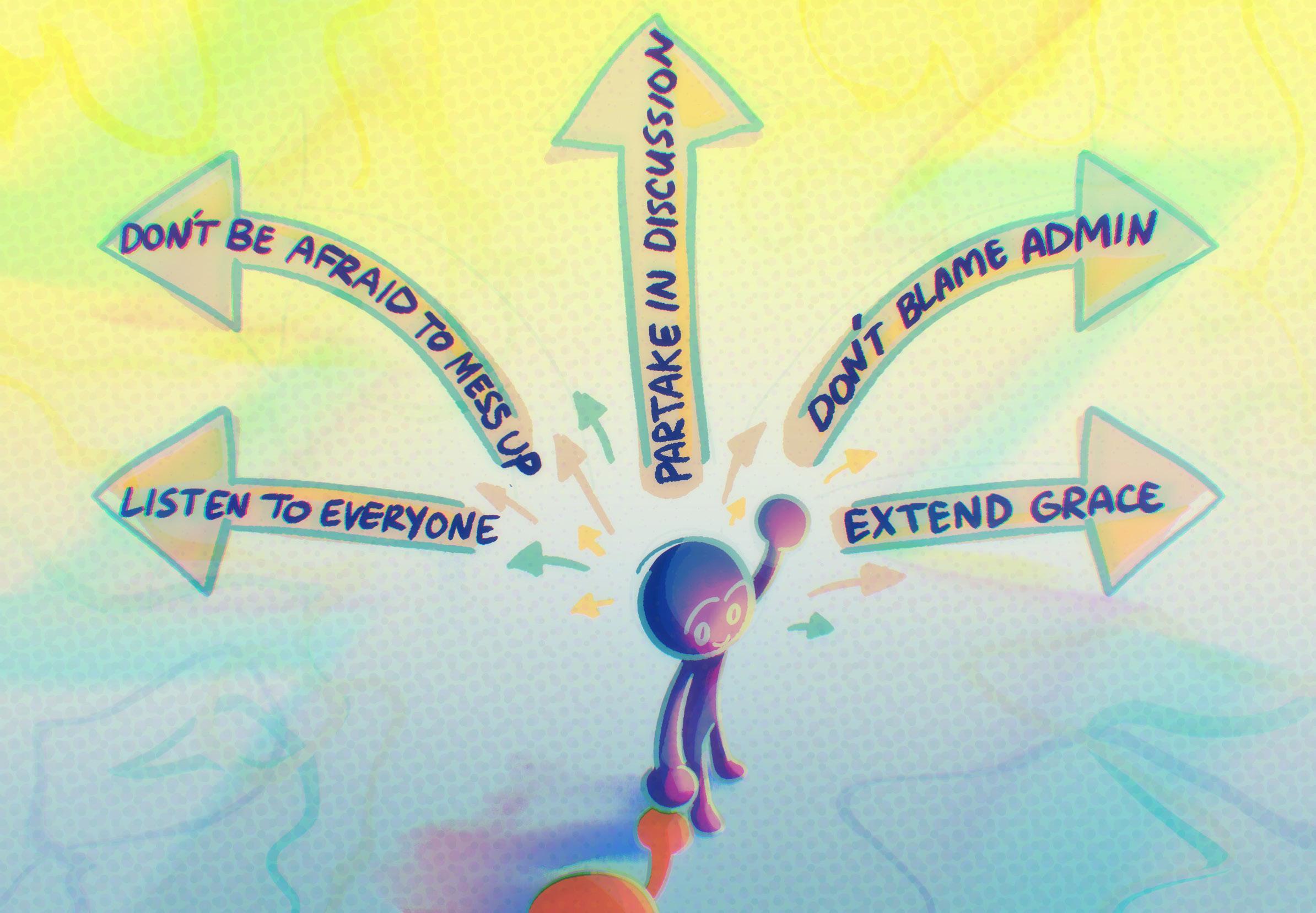
To make diversity training meaningful, engage when it’s hard
Clara McKoy
Eliana Mann
Rita Li
Mariam Malik
Lani Ngonethong
Greyson Sale
Siri Pattison
Lucy Thomas
Zadie Martin
Zimo Xie
Andrew Lipinsky
Nora McKoy
Thomas Chen
Davan Rosen
Aarushi Bahadur
Thomas Kovarik DIRECTOR
STAFF WRITERS
Lina Abid, Tamari Christopher, Sam Galarneault, Mati Halloran, Audrey Jansen, Soren Johnson, Gavin Leuthold, Peter Lipinsky, Murphy Miltner, Yassin Mokbel, Audrey Peltier, Nabeeha Qadri, Elizabeth Tuttle
CONTRIBUTORS
Carys Hsiung
ADVISER
Kathryn Campbell,
In recent years, the topic of diversity, equity, inclusion, and belonging (known as DEIB) has become divisive in educational institutions across the nation. Given this polarization, it is crucial that SPA continue to teach students how to engage across differences, including race, religion, and ability in order to reduce microaggressions and prejudices.
Diversity training aims to boost understanding of differences in students’ backgrounds and ideally equips students with skills to foster an inclusive environment. When done properly, it can transform perspectives and behavior, but in practice, students generally take a dislike to the countless numbers of assemblies followed by advisory discussions.
When students start feeling the strain of diversity training, they often take aim at a tool meant to encourage structured discussion: the Courageous Conversations compass.
While most of our explicit training and practices centers on the compass, the tool is widely regarded as ineffective, even used as a form of mockery against the school’s methods of diversity training at times. Student discomfort and complaints that the school’s DEIB practices are purely performative weaken the intended effectiveness of the compass as well.
Ironically, with a non-white student population of 39% in the upper school and a diverse demographic encompassing different racial, socioeconomic, and religious backgrounds, the limits of the compass lead many to stay silent in discussions about inclusiveness. This dissatisfaction is an indicator that some change must occur for diversity training to be effective.
The power for the student body lies not in what is offered, however, but in what we do with it. Whether the programming meets one student needs while another feels underserved, we are lucky to be able to have conversations around diversity at all. Recently, Republican lawmakers in a number of states including
Texas, Utah, and Florida have begun banning DEIB as a whole, and more states have put limits on what can and cannot be said in diversity training, according to an interactive map published by NBC News in March.
This school year alone, administration has worked to create plenty of opportunities to participate in diversity training. Textbooks have been replaced, speakers have been invited, clubs and affinity groups have been created… and all of this is just a snapshot of the many ways the school supports student-led initiative and institutional change.
With an arsenal of tools provided, lack of student participation isn’t an issue that administration can fix. Many students worry about saying the wrong thing and facing unnecessary backlash, and white students can feel that conversations about race and other identity markers are not their place to speak. Fear cultivates silence when open-mindedness to different perspectives is lost. As a solution, students can approach diversity training accepting that everyone’s experiences are different, and extend grace to peers who are trying to learn. Engagement can start as small as one individual engaging in the messy and incomplete conversation, leaving it with new thoughts and questions.
The goal of diversity training is to foster an inclusive and safe educational environment. When students do not utilize the multitude of tools at our disposal, its effectiveness drops dramatically. Engage in diversity discussions, whether they feel formulaic or spontaneous. Approach tough conversations with an open mind. Destigmatize the judgmental environment around diversity training and, instead of using the compass as an excuse, forge a path to understanding.
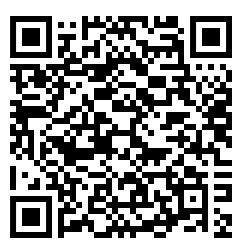
Scan this QR code to read a number of stories on diversity-related speakers and activities this year.
When Black actress Leah Jeffries was casted to play Annabeth Chase in the live action Percy Jackson series in May 2022, she faced comments like “I’m sorry, but a Black Annabeth just won’t fit,” and “Annabeth is written as a white girl so someone white should portray her.” The primary issue viewers brought up was that Annabeth had originally been described in the book series as a white girl with blonde hair, and Jeffries would be unable to fit that perception. This was not a one-time controversy; from Avantika Vandanapu being cast by fans as Rapunzel to the races of the Scooby Doo cast being changed in Velma, consumers of pop culture have continuously criticized POC actors and characters in traditionally white roles at the expense of greater diversity.

How can this diversity be defended? Percy Jackson creator Rick Riordan provided a great example with a statement released in the same month of Jeffries’ casting simply titled “Leah Jeffries is Annabeth Chase,” emphasizing the search for an actor who could bring the character’s personality to life. “You are judging her appropriateness for this role solely and exclusively on how she looks. Friends, that is racism,” he wrote. Riordan made his priorities clear: POC actors should not have to justify their existence simply because of their race when they fit a role in every other aspect.
The crucial aspect of diverse casting is recognizing the role of race in a character’s identity and the sto -

ry’s plot. For example, Tiana from Princess and the Frog should not be played by anyone other than a Black woman, because the large population of Black and Creole people in the movie’s setting, Louisiana, is an important part of Tiana’s character and development. Additionally, as one of the only Black Disney princesses, taking away the already minimal representation of Black girls continues to erase their presence in pop culture.
On the other hand, a character like Ariel from The Little Mermaid, with no notable racial or identity beyond being white and the added ambiguity of being a mermaid, could be played by an actor of any race. However, when actress Halle Bailey was casted to play Ariel in the live action movie, she faced a significant amount of criticism simply for being Black and not fitting viewers’ perception of the character - a white girl with red hair. Wanting to preserve the authentic-
ity of a character’s portrayal is a valid sentiment, but there’s a fine line between maintaining accuracy and feeling uncomfortable seeing POC in traditionally white roles.
The question at heart is why there aren’t more POC characters to represent in the first place. It’s unfortunately inevitable that POC actors will face criticism when playing roles that have traditionally portrayed white characters. While supporting these actors and recognizing their abilities to play certain roles is a good first step, creating spaces for POC actors to thrive as themselves is ultimately necessary. Original POC representation such as Miles Morales from the Spider-Man series and the Wang family in Everything Everywhere All At Once successfully portrays POC characters in stories that fit them, providing a model for other works to follow suit. Representation in media is important; consider who needs it most.
The proportion of Minnesota Democratic primary votes cast for “uncommitted,” more than any other Super Tuesday state.
INFORMATION: CBS News
Voting uncommitted sends a message to candidates, asking them to reconsider their stances on particular issues.
In the most recent Minnesota Democratic presidential primary election nearly 46,000 or 18.8% of voters made
the concerted effort to vote “uncommitted,” according the the Secretary of State official results, in response to President Biden’s position in the current Israel-Hamas War.
An uncommitted vote in a primary means that although the voter supports a certain political party, they are not committed to any of the candidates. While some uncommitted voters are truly uncertain about which candidate they’d like to choose, many were using their vote in this primary as a protest against President Joe Biden’s response to the Israel-Hamas war.
Minnesota was just one of several states where there was debate as to whether or not these protest votes were effective. In Michigan, almost 79% of majority-Arab precincts voted uncom-
senior McKinley Garner

mitted, according to the Department of State official results. While it is difficult to provide quantitative evidence that protest voting will change policy, these uncommitted voters are signaling to President Biden not to take their vote for granted in the general election.
With Joe Biden running essentially unopposed, except for longshot Rep -
resentative Dean Phillips, Biden was undoubtedly going to win the nomination. Therefore, the uncommitted voters were not trying to oust Biden, but rather were trying to exert some pressure on him to change his Middle Eastern policies. With a tight general election ahead, President Biden will need to coax as many uncommitted voters as possible, lest they stay home on election day. While it is difficult to quantify the impacts of voting uncommitted, there are no negative impacts. If and when you vote in future elections, it is important to understand that voting uncommitted can also be an effective option. It might just send a message.
Commit to a cause. Commit to a candidate. But most of all, commit to voting without the commitment.
The recent Minneapolis City Council decisions triggering Uber and Lyft’s departure in the various Twin Cities and Metro Areas will be bad for everyone: drivers will face unemployment, regular users with disabilities that require the service will be stranded, and some fear airport transportation will be an added obstacle to a flyer’s agenda.
Everyone has been there: they’re running late for a meeting, game, dinner, or flight, and their planned ride falls through. But don’t stress it — a ride is always available at the press of a button. Within five minutes, a friendly driver appears for a hasty arrival at the destination, maybe only two minutes late.
THE RECENT MINNEAPOLIS CITY COUNCIL DECISIONS TRIGGERING UBER AND LYFT’S DEPARTURE ... WILL BE BAD FOR EVERYONE.
junior Georgia Ross

For rideshare users with various disabilities preventing them from driving their own vehicles, this operation is often a more strategic and common routine.
But on Mar. 7, when the Minneapolis City Council overrode Mayor Jacob Frey’s veto and passed an ordinance that requires ridesharing companies to pay drivers a minimum rate of $1.40 per mile and $0.51 per minute, all rideshare accommodations became jeopardized.
For months, Lyft and
2009 - Taxi Magic app launches, providing easier access to cabs in Minneapolis.
2012 - Uber announces on the former social media platform Twitter its plans to expand to Minneapolis in the fall. Lyft follows suit months later.
2024 - Minimum pay ordinance is passed by the City Council. Uber and Lyft announce their departure from Minneapolis, postponed until July 1.

2011 - Minneapolis City Council votes to eliminate the cap on taxi medallion holders in 2011, leading to a surge of nearly twice the amount of cabs between 2007 and 2012.
2014 - Both companies arrive early in the year, but are met with challenges from city enforced taxi laws. Ordinance regulations pass later on in July, allowing “transportation network companies” to operate while enforcing driver background checks, proper training, and car inspections.
2016 - Uber and Lyft are granted access to the Minneapolis-St. Paul Airport, further solidifying their dominance over other cab companies and competing apps.
INFOGRAPHIC: Orion Kim
INFORMATION: Star Tribune
GOING PLACES. The history of rideshare services in the Twin Cities is relatively short, but in that time, companies like Taxi Magic (now Curb), Uber, and Lyft revolutionized the way people get around. After the Minneapolis City Council’s decision, their future is uncertain.
Uber rideshare drivers have been dissatisfied with the companies and advocated a rate increase. Council members and those in agreement with the ordinance expressed that drivers, many of which are East African immigrants or workers of color, are exploited by the companies for cheap labor. Supporters say that their rate increase proposal will ensure that drivers are paid a minimum wage of $15.57 per hour. However, according to a state report on driver pay that came out hours after the council’s decisions, a rate of $0.89 per mile and $0.49 per minute would meet the same minimum wage requirement — a rate which Uber and Lyft
have agreed to support.
Immediately after the Council’s decision, spokespeople from Uber jumped into the conversation and declared that Uber would terminate its ridesharing services in not only Minneapolis, but also Saint Paul and the surrounding Twin Cities metro area, effective May 1. Similarly, Lyft will follow their lead, but only in the city of Minneapolis. (The date was later postponed to Jul. 1.)
While some believe that other companies will use this upheaval as an entrance into the Twin Cities rideshare industry, Governor Tim Walz, Frey, and the Federation for the Blind hold deep concerns. The Federation
CONFLICTS OF INTEREST
for the Blind worries that it could take significant time for other companies to get licensed and start providing services, given that the process takes time to acquire a license, pay the city a fee of $47,760, and carry out formal review. Because rideshare services are essential for those with disabilities who cannot drive, Lyft and Uber’s departure will affect them disproportionately.
Meanwhile, some rideshare drivers oppose the change because they make a sufficient amount of money through their job and fear unemployment.
Come Jul. 1, the Twin Cities will see if the Council’s bid pays off.
NAME AND PRONOUN USE
The Rubicon uses the name and pronouns reported by the individual source. Each interview and survey begins with a request to say and spell the person’s name and to share the pronouns they would like to see published in the story, and the reporter is transparent about where the story will be published. If a mistake is made in the course of reporting, a correction will be posted per the corrections policy.
The Rubicon news and Ibid yearbook avoid conflicts of interest while also honoring the fact that our reporters are involved in the school and local community beyond their work on staff. Staff members avoid writing about students, teachers, student clubs, affinity groups, and organizations that they are closely involved with. The reporter is always responsible for disclosing conflicts of interest, and if a conflict of interest comes to light after publication, it does not warrant removal of the story. If it is in the best interest of a source to be interviewed by a close friend in the case of a sensitive topic, the interviewer will not write the story—they will solely conduct the interview. Unavoidable conflicts of interest are specifically mentioned at the top of the story. Photographing news events is never a conflict of interest.
ORION KIM co-EDITOR IN CHIEFLocated at the heart of Capitol Hill and with the entire world watching their every move, U.S. presidents are held to a higher standard than the average American. Every misstep awaits global appraisal, and every controversial statement is likely to receive immediate backlash.
Many of the same laws apply to the president just as they would to any other U.S. citizen. Their lies and misinformation are protected by free speech, despite the indisputable power and influence that their voice holds.
According to the Washington Post, both President Trump and President Biden were guilty of making false or misleading statements during their first 100 days of presidency, a documented 511 for Trump and 78 for Biden. While presidents should always be held accountable for misinformation, it’s important to acknowledge this burgeoning disparity. With upcoming elections, seeking out the truth should be a virtue that voters prioritize.
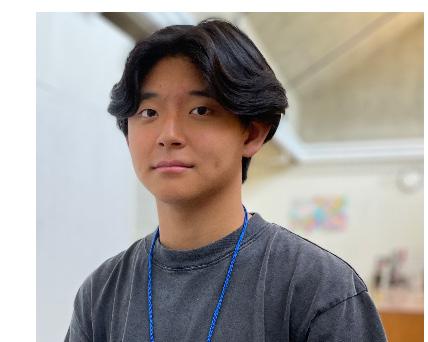
These lies can have detrimental reverberations amongst a president’s supporters, causing them to hold inaccurate beliefs that affect policy and public sentiments. Another recent Washington Post survey found that six years ago, only 26% of Republicans believed that millions of fraudulent votes were cast in the 2016 election, and now that number has risen to 38%. When Americans blindly believe false statements, it can drive the country into a state of polarization and discord.
Despite the large impacts their lies can have on the U.S. public, the president is arguably more invulnerable to consequences than the general public. Although the Supreme Court doesn’t uphold that presidents are immune to criminal prosecution, the Department of Justice has historically pointed to a clause in the Constitution that says imposition of criminal punishment would incapacitate the president. According to Saikrishna B. Prakash, senior fellow at the University of Virginia, the only legal way to remove a president from office is by the 25th Amendment or impeachment.
Regardless of current legal proceedings, these laws aren’t going to change, so fact-check presidential candidates. They aren’t some morally unproblematic figure, and they surely aren’t incapable of manipulating the truth or spewing blatant lies to gain political fame.

This column marks the last First Amendment piece that I will publish for The Rubicon; however, my journey as a Free Spirit is far from over. I expect to carry on my exploration of the First Amendment in the future, building off my time spent representing Minnesota at the Al Neuharth Free Spirit Conference and learning about the Constitution from decorated journalists and experts in law, plus my time writing my column and addressing a variety of constitutional issues. It’s my greatest hope that all of you also keep informing yourselves about this most fundamental piece of American democracy.
“So are you going to, like, die?”
“But you don’t look sick?”
“Have you tried XYZ?”
These are all examples of some questions a person living with a chronic illness may face when sharing their diagnoses and experiences with peers.
The alternative of not sharing can often lead to feeling isolated socially and that they are facing their condition alone.
Illness and disability are virtually unavoidable for humans, even if it’s a simple week-long cold. But for some, daily illness affects all aspects of ordinary life.
According to Frontiers in Public Health, chronic illness is defined broadly as conditions that last one year or more, possibly requiring ongoing medical attention and limiting activities of daily life. Some of the most prevalent include cancer and diabetes.
Chronic illness is undoubtedly common in the United States, as data from the CDC reports that nearly 45% of Americans live with one or more chronic illnesses, specifically around 6 in 10 adults and 4 in 10 teenagers.
Chronic mental illness is also heavily prevalent, as the U.S. Health and Human Services reports that 1 in 5 adults experience mental illness each year.

HELPING HANDS. properly support someone with a chronic or mental illness, learning when to listen and when to lead the conversation is crucial. Above all, respecting the other person’s privacy and feelings will contribute to a healthy relationship.

can cause tension in the relationship and possibly the feeling of being a burden.
For friends, it can be intimidating to discuss something that feels outside of their expertise.
Upper School Counselor Heidi Lohman directly supports students with learning plans related to chronic and mental illness.
“Speaking generally I think [the conversation] is really up to the person who is experiencing chronic illness,” Lohman said.
However, ignoring a person’s health only furthers the issue. As the International Journal for Research and Public Health discusses, social isolation is a leading result of chronic illness. Without an outlet for emotional release and socialization, a person is discouraged from discussing it entirely.
To lead a conversation, start in a private, nongroup setting. If a person is going through a tough time with their health, that may not be the best time to ask questions, but instead, ask if they need anything. Ask how a person is doing physical and mental health-wise.
Sometimes, just a tiny question is validating enough.
Other times, leading a conversation means feeling uncomfortable and okay with not always understanding what they are going through.
Senior Emma Krienke has Celiac, a chronic autoimmune disorder that affects gluten digestion.
She generally feels comfortable having conversations about her illness, but “I definitely don’t get into the depth of what it can do to me... I keep it light-hearted,” she said.
Historically, chronic illness and pain have been connected to older generations; as Frontiers in Public Health reports, the mean age for those under long-term treatment is between the ages of 60 and 79.
However, that age average is rapidly decreasing with growing mental illness rates among teens and children.
Inpatient clinics and
INSTEAD OF SAYING
hospitalizations as a result of mental illness have increased as well. The Health Care Cost Institute calculated that 30% of minors in long-term care at hospitals in 2020 were there for psychological care.
But for those who love someone with a chronic illness, physical or mental, it can be hard to find a way to address their pain while also respecting their boundaries. The roles in these conversations differ based on people’s relationships
“Everyone experiences aches and pains.” OR “Everyone gets tired.”
INSTEAD OF SAYING “You’ll be fine.” OR “At least you’re young.” OR “But you don’t look sick.”
and comfortability with sharing.
For family and friends, the roles are either leading the discussion with their loved one or serving simply as a listener. A person’s relationship also impacts their role in the conversation. Caregivers often talk about illness the most out of necessity, which
For friends and non-caregiving families, there are two essential roles a person can have: a listener or a leader. These often depend on the situation. If a friend for a listener, then listen. However, if a person is struggling, leading the conversation is more fitting.
“The only time that I would say somebody would initiate that conversation would be when we notice that they might need more support,” Lohman said.
Making sure to validate the person outside of their illness is just as crucial as the focus on their health. Remember that they are a whole person; there is much more to them than any health complications they may be dealing with.
When it’s more appropriate to be a listener, be just that. Stay engaged and allow them to speak on their terms.
Most importantly, never force someone to share their private health information. Although someone might share health details with one person, that does not necessarily mean they are comfortable sharing that information with everyone.
SAY “I imagine that must be difficult.” AND “I am here for you.”
SAY “I understand that [insert illness] can be debilitating. I can’t imagine what it must be like, but know that I am here to support you.” AND “I am proud of how hard you have been working for your health.”
24.7% of Minnesotans with insurance were not satisfied with insurance protection from high medical bills in 2023
24.5% of Minnesotans went without some type of healthcare due to high costs in 2023
From boiled potato peels to tackle gray hairs or eating carrots to remove freckles, the @myhealthyhacks account on TikTok seems to have a cure for everything.
Similar accounts on the video-sharing platform promoting beauty and health remedies are backed only by pseudoscience.
While these simple folksy, science-free remedies seem harmless, they start the misinformation ball rolling on social media platforms, which results in more severe mistrust of vaccines and other scientifically proven methods.
Sophomore Nora Seifert has seen suspect TikTok medical advice: “I’ve come across a lot of hacks on TikTok about how to cure things or self-diagnosis type things,” she said. “I’m a little bit worried about [these videos being online] because I feel like a lot of people try these types of things…or this can cause them to not really go to a doctor.”
According to a GoodRx study, 70% of people were exposed to medical misinformation in 2022.
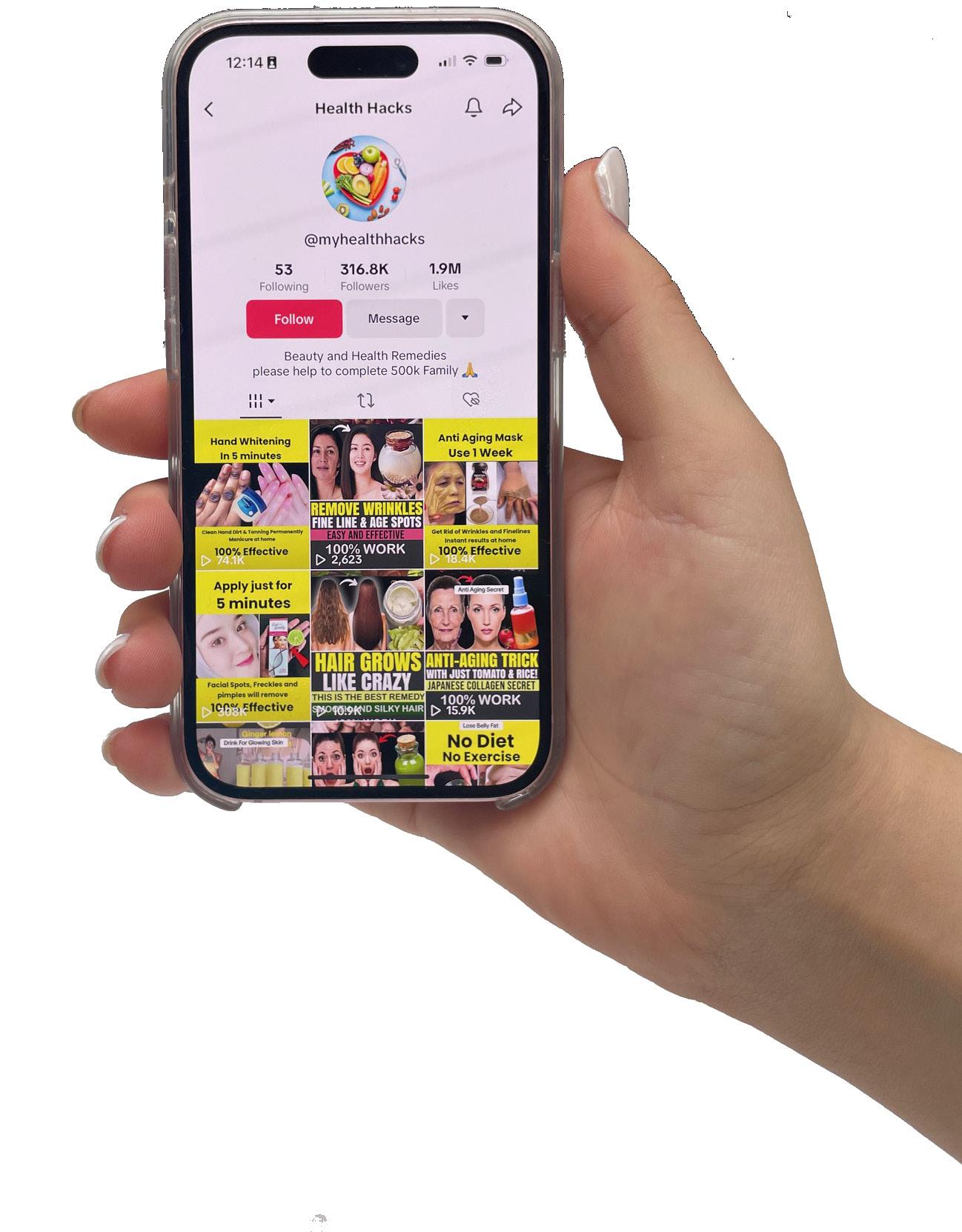
Junior Bora Mandic is concerned about the implications of medical misinformation.
“If people see [medical misinformation] and then don’t realize it’s fake, it could shape how they view certain topics. It could really cause a chain reaction,” Mandic said.
He cited the numerous anti-vaxxers who have raised concerns on social media about the COVID-19 vaccine: “...during COVID, people were talking about how [the vaccines] were implanting chips into them,” he said.
When it comes to vaccines, falsehoods spread like a virus and, left unchecked, could spread, undermining public health efforts.
of adults say that they have heard one of five false COVID-19 vaccine claims and believe it is definitely or probably trust 45% said that, out of eight soruces, they would trust health information from YouTube at least a little 52% of adults report using social media at least weekly for health information and advice
Orion
HACK HAZARD. While there are certainly some creators who give viable medical advice on social media, many accounts post infactual or even harmful medical “hacks” that could mislead viewers. In general, it’s a safe bet to steer away from online social platforms and obtain medical information from trusted sources and providers.
Freshman Langston Thompson said the best way to combat this misinformation is to seek reliable sources.
“If I see something that’s from a licensed doctor, I’d be inclined to trust him more than something posted by any regular person,” Thompson said, who, likewise, mostly encounters medical misinformation about COVID vaccines.
“Some people thought there was a virus or something in the vaccine,” he said. Overall, he feels perpetuating these falsities is
cause for concern. “There are dangers to just hearing one side of a story,” Thompson said.
The Supreme Court’s decision to temporarily halt a ruling that prevents federal officials from interfering with or influencing social media content could have implications for spreading medical misinformation.
Arguments for promoting online medical quackery cite free speech and information.
Alternatively, if federal officials could somewhat control content moder-
ation on social media platforms, the Biden administration believes it would reduce the spread of medical misinformation.
The preliminary injunction issued by lower courts, attempting to prevent federal officials from controlling media content, is pending further review by the Supreme Court, which began hearing arguments at the beginning of April.
DIVERSE CULTURES.
Although the Hmong community originate from many places in Asia, junior Serene Kalugdan’s family is from Laos.
 JUAN MIGUEL ADAMS
THE RUBICON
JUAN MIGUEL ADAMS
THE RUBICON
Amidst Minnesota’s diverse culture pot of people, Hmong culture has preserved its traditions, celebrations, and values. With over 12 million Hmong people in the world, the culture has grown greatly.

1880s
Wave of Arab immigration to U.S.
Hmong culture is transnational within each community, and depending on the area, the culture can differ. For instance, the Hmong language has several dialects, with the two main ones being White Hmong (Hmong Daw) and Green Hmong (Hmong Njua). White Hmong is typically spoken in northern regions of Laos and Vietnam and Green Hmong in southern regions. However, a unifying characteristic is the 18 clan-based societies associated with last names and the clan or family to which one belongs.
At SPA, the Hmong community makes up very little of the student population; however, it is a highly prominent culture within Minnesota, making up more than 5% of the population, according to Minnesota Compass.
Junior Serene Kalugdan grew up frequently practicing Hmong traditions with her family.
“In my values, I always put family first. For me, being Hmong means being with my family and embracing your culture,” Kalugdan said.
Kalugdan has also experienced challenges with her
1980
Largest wave of Hmong immigration in MN after the US Refugee Act of 1980
Hmong identity, specifically in the rules followed by Hmong clan affiliates.
“Since the last names are so tightly connected to the clans, it means that if you marry someone outside of Hmong culture, you lose your clan,” she said.
Hmong New Year serves as a celebration of culture, a way to give thanks to ancestors, and a welcome to a new beginning. The tradition takes place all over the world, but in St. Paul, at the River Center, a huge annual celebration occurs, with more than 30,000 Hmong people coming from Minnesota and all over the world.
Sophomore Lani Ngonethong has grown up attending the celebration her whole life: “It is amazing to see all these young kids from California and outside of Minnesota, and you get to dress up, and everything is so pretty,” Ngonethong said.
Because of the SPA student body’s small community of Hmong students, it is easy to lose culture.
“Hmong is rarely spoken, especially with the next generation, and my mom always told me at this rate, in 50 years, the language could die out,” Ngonethong said.
Hmong culture emphasizes relationships and celebrating traditions. In the SPA community, Hmong students continue the culture by acknowledging and appreciating the values and beliefs that come with it.
Arab American Foundation advocates for Arab American heirtage Month
MN Hmong population exceeds 94,000
1975
First Arabs immigrate to U.S.
First Hmong family resettles in MN
MN Governor Mark Dayton recognizes Hmong American Day
U.S. President Joe Biden officially recognizes Arab American Heritage Month
SONIA KHARBANDA THE RUBICON
Freshman Lina Abid vividly remembers being asked the fateful question, “What are you?” in elementary school, and not knowing how to respond. “I remember telling [a classmate] my whole life story because I didn’t have an answer,” she said.
Abid’s story is one that crosses countries and cultures. Born in Saudi Arabia to an American mother and a Tunisian father, she lived in Syria as a baby, and then in Tunisia as a toddler. She doesn’t remember much from those early years abroad, but she hears stories about life after moving: “My mom told me that she still has this list of words that she had to give my preschool teacher that were French and Arabic words … because I was so confused about the language that I was supposed to be speaking,” Abid said.
Sophomore Ella Judeh has also noticed the misconceptions surrounding her Arab-American identity.
“I feel like there’s a lot of stereotypes about Arabs [that] are mostly not true,” Judeh said.
For Abid, this confusion often appears in surveys and questionnaires: “[Arab-American is] not really a box,” she said. “I haven’t known how to approach how I … identify myself,” Abid explained, “I don’t really experience discrimination … but I still feel like [my Arab identity] is a part of who I am.”
While April was officially recognized as Arab American Heritage Month, neither Abid nor Judeh did anything in particular to commemorate the month. Judeh
spent much of the month celebrating Ramadan and Eid with her family and the Muslim Student Affinity group.
Despite the questions their identities can sometimes bring, both Abid and Judeh recognize their cultures as a point of pride.
“I’m very proudly Arab … I feel like it just makes me different than other people [at SPA],” Judeh said.
Since moving to the United States and losing her knowledge of Arabic, Abid longs for a deeper connection to her Tunisian heritage.
“I was really proud but … I was always kind of looking for more connection with that part of who I am,” she said.
Judeh’s father, who is from Palestine, has immersed her in their culture from a young age, including through language: “My dad tried to teach me Arabic … but that didn’t go so well,” she said. She also spent time going to the mosque with him, listening to the Koran, and talking to their family back in Palestine.
She has found a community and safe space within the Muslim Student Affinity group: “At school, I feel very comfortable about it, especially when I’m with the Muslim affinity group because we can all talk about whatever we want there, so it feels very welcoming,” Judeh said.
Similarly, over time, Abid has come to terms with the confusion surrounding her identity.
“I feel like I don’t have to give [people] my whole life story anymore,” she said.
A COLLEC-
TION OF COUNTRIES. The Arab League consists of 22 different nations across the Middle East and Northern Africa and is represented by a green flag with a 22-link chain, representing each of the countries.



88% of unrecycled plastic ends up in landfills or oceans
Biking, carpooling, and public transport reduce carbon emissions
Senior Henry Hilton is seeing green: in the budding trees, in the sustainability committee he chairs and during the Earth Week event he founded.
Hilton sees climate change in action. “I’ve been exposed to not only the beauty of the outdoors and the nature around us here…but I’ve also been exposed to how that beauty has changed,” he said. “[We planned] competitions that are going to hopefully create a precedent of sustainability.”
Students celebrated Earth Week as a time to foster environmental stewardship. Preceding Earth Week, the USC sustainability committee pursued initiatives, such as implementing Meatless Wednesday and creating a sustainability statement. Additionally, the USC sustainability planning committee created Earth Week challenges, hoping to inspire students to keep sustainability in mind.
“This year, there are two competitions we have planned. There’s a bike to school day or carpool day,” Hilton said.
USC tallied up everyone in each grade who biked to school or carpooled for a school-wide competition on Apr. 24, and in addition, gave each individual who partook in the challenge a donut.
Removing beef and lamb from menus reduces carbon emissions
INFOGRAPHIC: Annie Zhang
INFORMATION: Energy.gov
ACCESSIBLE SUSTAINABILITY. Even the small, daily habits can help an individual live more sustainably. For example, reducing the amount of beef eaten or picking up a friend on the way to school can reduce carbon emissions.
Another challenge was a compost challenge. “We [had] four different compost bins instead of two. It [was] a different one for each grade. And then we’re gonna see which one is the most filled,” Hilton said.
Besides these challenges, USC hosted a sustainability-themed club expo. The founder of the Nuclear Club, senior David Hsu, has been interested in nuclear energy for years, and he made a poster for the Earth Week club expo on Apr. 25.
Hsu thinks the presentation will educate people about renewable energy sources and the dangers of fossil fuels. “The poster will be a demonstration presenting nuclear energy as a potential solution in order to minimize the usage of fossil fuels,” he said.
Climate change is a bigger issue than a single policy can fix.
“The problem with sustainability is that it’s often grouped into political points of a left-leaning person, and it’s just kind of lumped into one boiler plate of political views…it’s so much more,” Hilton said.
Hilton hopes that USC’s sustainability initiatives will carry into future years. “I’m hoping that it can become a new tradition at SPA. I’m hoping people will embrace it,” Hilton said.
The event kicked off on Earth Day, Apr. 22, and ran through Apr. 26.
A single tree, a power line, or the name of a noteworthy river: for geography buffs, this might be all they need to identify a specific location anywhere on the globe.
Junior Adam Ebert started getting into “GeoGuessr” a few months ago because of online videos, and he’s picked up on strategies and geographical features fast.
I WAS A WORLD WAR
KID
WHEN I WAS REALLY LITTLE... THEN... I STARTED TO MOVE INTO POLITICS... “
sophomore William Hanna
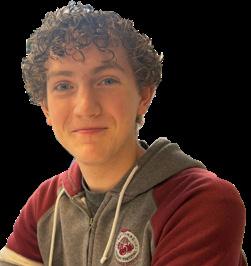
“You get a feel for it much quicker than you would expect, because places have a lot of different features that you can pick up on,” Ebert said.
However popular “GeoGuessr” may be, though, many others pre-

fer a more map-based approach, focusing on naming countries, states, and capitals.
Senior Kate Jacobs prefers to play a variety of geography quizzes on a trivia site called JetPunk. She became interested because of her older brother, who ended up going to the state-level National Geographic Geo Bee in middle school.
“I like to beat him at stuff, so I tried to learn some more geography,” Jacobs said.
Over time, she’s honed
her skills through JetPunk quizzes, especially the Countries of the World quiz, which has the player name every country in the world as quickly as possible. She sometimes completes them with a group of like-minded friends during Tutorials and X-periods, and she enjoys the social aspect.
“I think it’s more fun when you do it with other people, although it is a little stressful,” Jacobs said. “If you guess wrong, you might get made fun
of.”
Sophomore William Hanna prefers map-style games as well, specifically “Seterra” and “Travle.” “Seterra” has the player quickly click on the country it names in as few tries as possible, and Hanna’s favorite version includes all 193 United Nations member states. “Travle” is a Wordle-style daily challenge game where the player tries to create a path from the two named countries with as few border crossings as possible. For Hanna, geography
games serve as a supplement to their real passion: global affairs and geopolitics.
“I was a ‘World War II kid’ when I was really little … which was really weird. Probably bad,” Hanna said. “But that was when I really first started looking at maps and figuring out where things were … And then at the beginning of seventh grade, that was when I started to move into politics and world affairs.”
The games also help them study for Quiz
Bowl, where questions often involve identifying countries based on capitals or bordering nations. (According to Hanna, “the answer’s always Chad.”)
Overall, they believe that even beyond their own personal interest in geography, it’s incredibly important for everyone to learn about the way the world is put together. Doing so helps people engage thoughtfully with those that come from different cultural contexts.
“The world that we live in is so connected, and once you get to a certain age and a certain level, you start meeting people from all over the world,” Hanna said. “I think that it’s honestly the kind thing to do, but also the responsible thing to do, to have an understanding of what the world looks like and how it works.”
For this group of students, part of creating their global consciousness looks like logging a few hours on geography games every week, learning about foreign capitals, borders, and architecture — going beyond the U.S. bubble, if only for a moment.
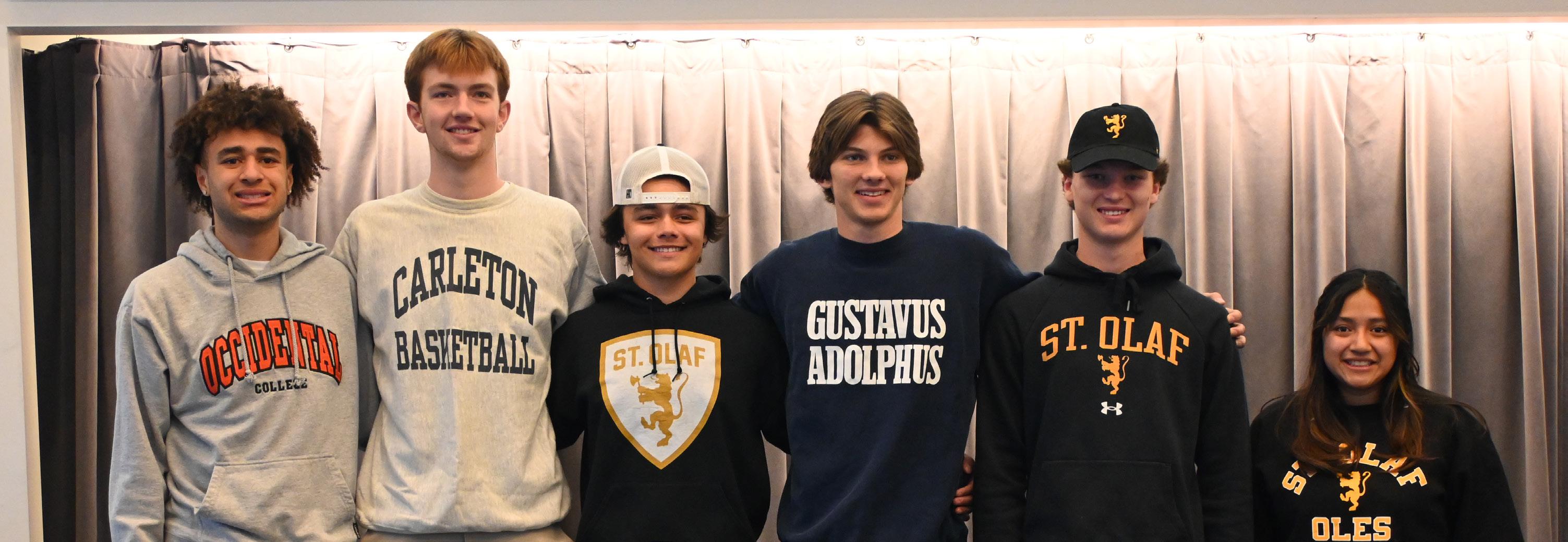
A little over 7% of all high school athletes will go on to play at a varsity level in college according to the NCAA. On Apr 17., the athletics department celebrated six seniors who are joining that small group: Cooper Olson, Tysen Hayes, Naomi Kempcke, Ethan Carter, Griffin Schwab-Mahoney, and Will Black.
Committed athletes attended the signing event with families, coaches, and close friends who supported their athletic careers. Each student gave a short speech about why they made their decisions, thanking specific people, and proceeded to sign their commitment forms.
After a historic senior season with the Spartans, Ethan Carter will play Division III basketball for the Occidental Tigers in Los Angeles, California. After dedicating so much time to the sport, he felt that continuing to play basketball would be the right course of action. He also prioritized his future academic experience during his college search with plans to study kinesiology.
“[Occidental] is in the general area that I wanted to be in, and it’s also just a really good academic school, which I would probably go [to] even if I weren’t playing basketball, so I thought why not?” Carter said.
Unlike Carter, girls basketball captain Naomi
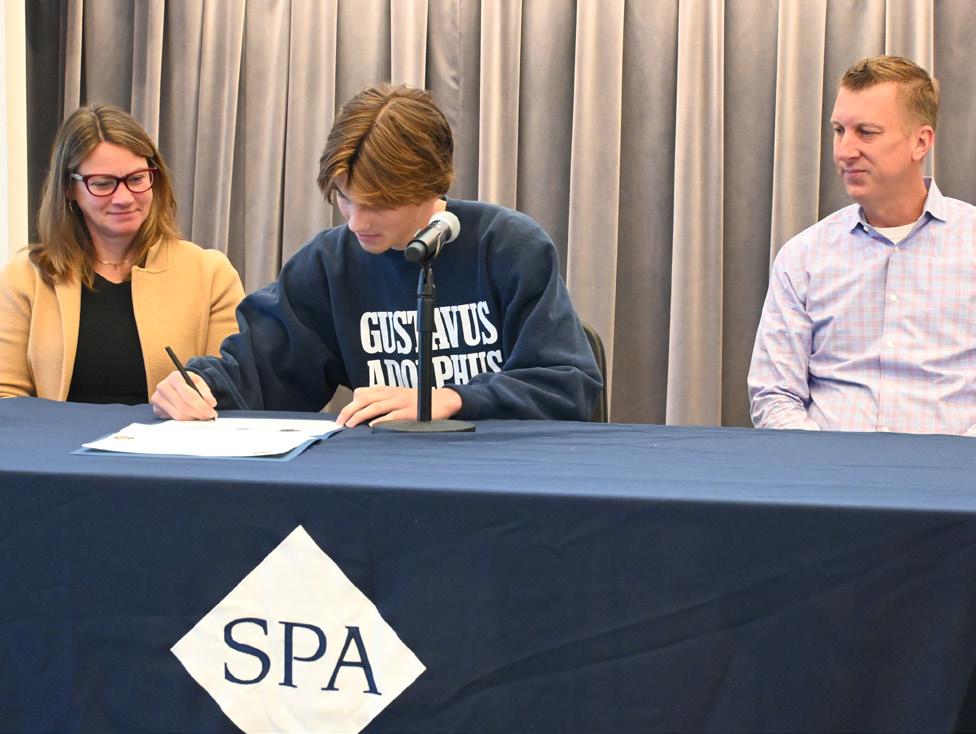
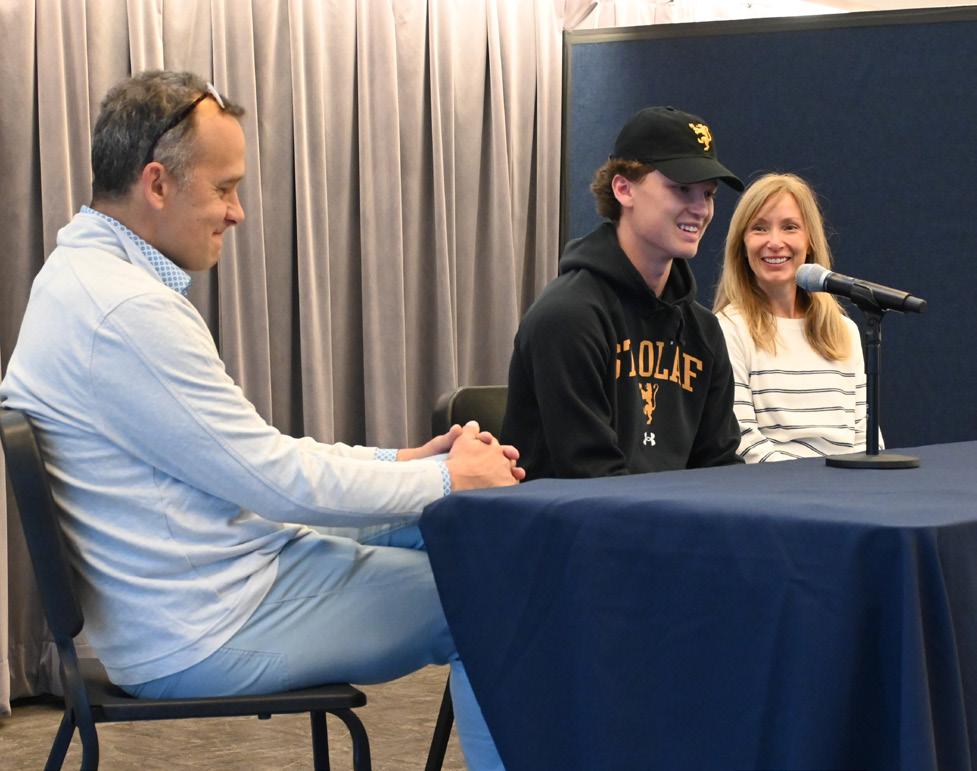
Kempcke did not think she would continue playing basketball until the end of her junior year. She will join the St. Olaf College basketball team
“
see if I could extend my playing opportunities at college,’” she said. State soccer champion goalie Cooper Olson will play Division III soccer
I [THOUGHT] I LOVE THE SPORT ... I SHOULD TRY TO SEE IF I COULD EXTEND MY PLAYING
senior Naomi Kempcke
in Northfield, Minnesota. After communicating with the coach about a potential spot on the team, a boost in confidence during Kempcke’s senior year set her plan in stone.
“I [thought] I love the sport of basketball, and maybe I should try to

for Gustavus Adolphus College in St. Peter, Minnesota. For him, the priority was how comfortable he felt with coaches during his college search. The renowned soccer program, facilities, and academics of Gustavus also made the decision to continue easier for Olson.
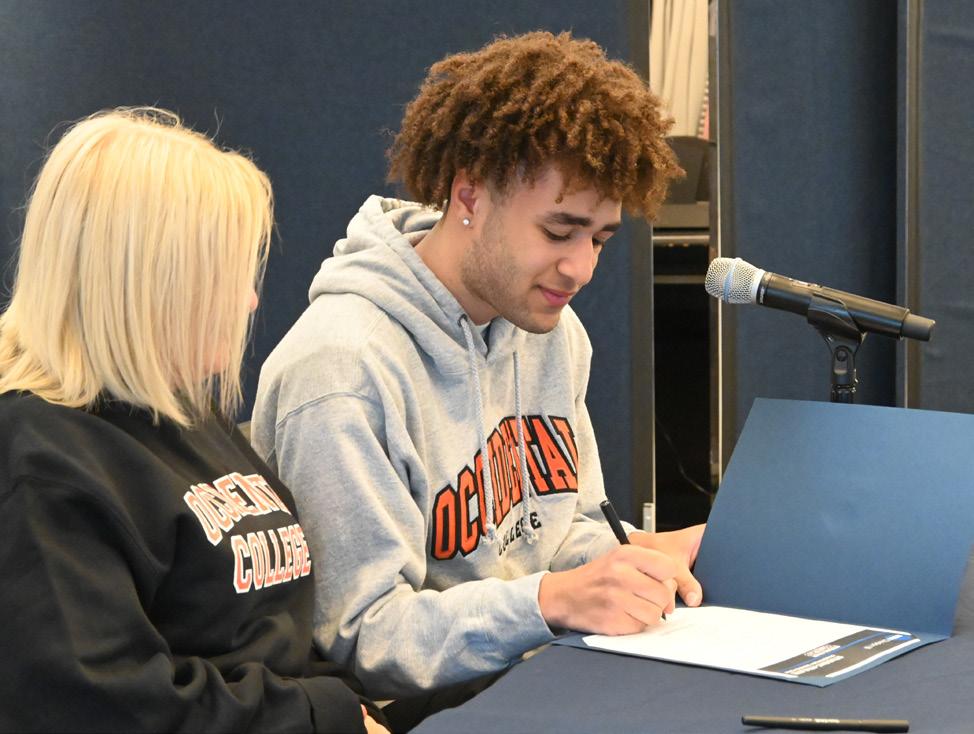
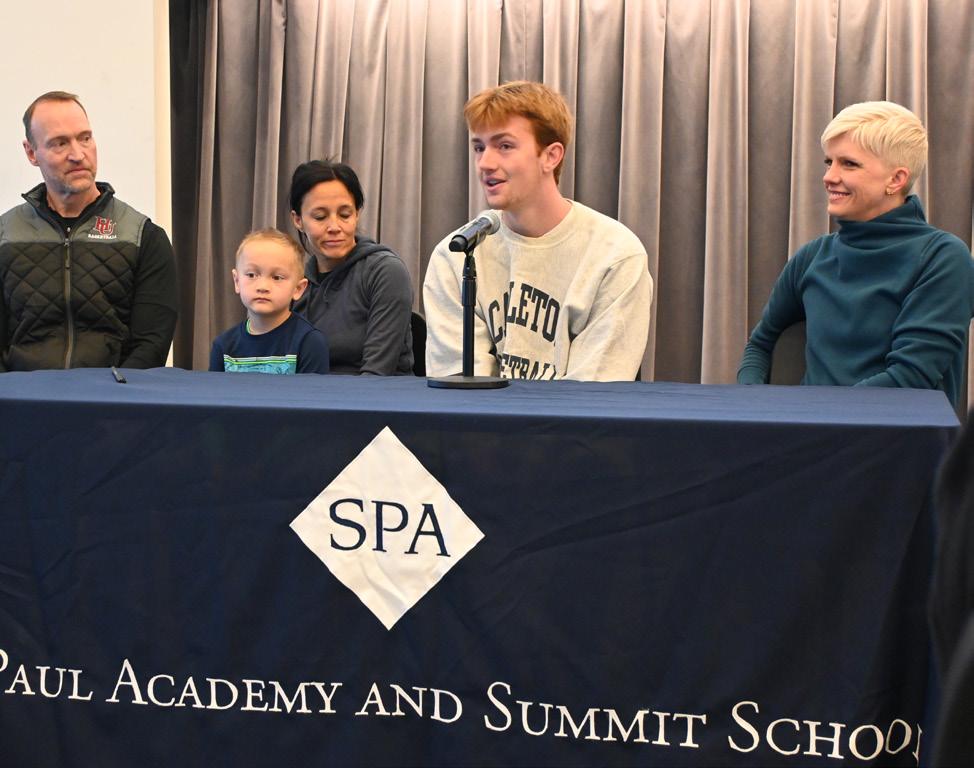
“I know that there were other coaches that I talked to that probably were in it for them[selves], but this coach was just really honest with me and I knew that I could trust them,” he said.
The most difficult part of Carter’s recruitment was getting in contact with coaches due to geographical differences. After he reached out to the Occidental coaches, “[They] really did most of the work of recruiting me and watching my film,” he said.
Olson looks forward to getting a fresh start in college while continuing his role as a goalie.
“You’re like the baby of the program once again … and I might
have to carry a couple of ball bags around and pick up cones all the time, but I’m okay with that,” he said. “I think it’ll be fun to once again be able to learn from new people and get guidance from upperclassmen.”
For others who are considering to play varsity sports in college, Carter emphasized the importance of putting academics first. From Kempcke’s experience, confidence is key during the recruiting process.
“If people are saying that you can play in the next level, you totally can, even if you’re doubting yourself,” she said.

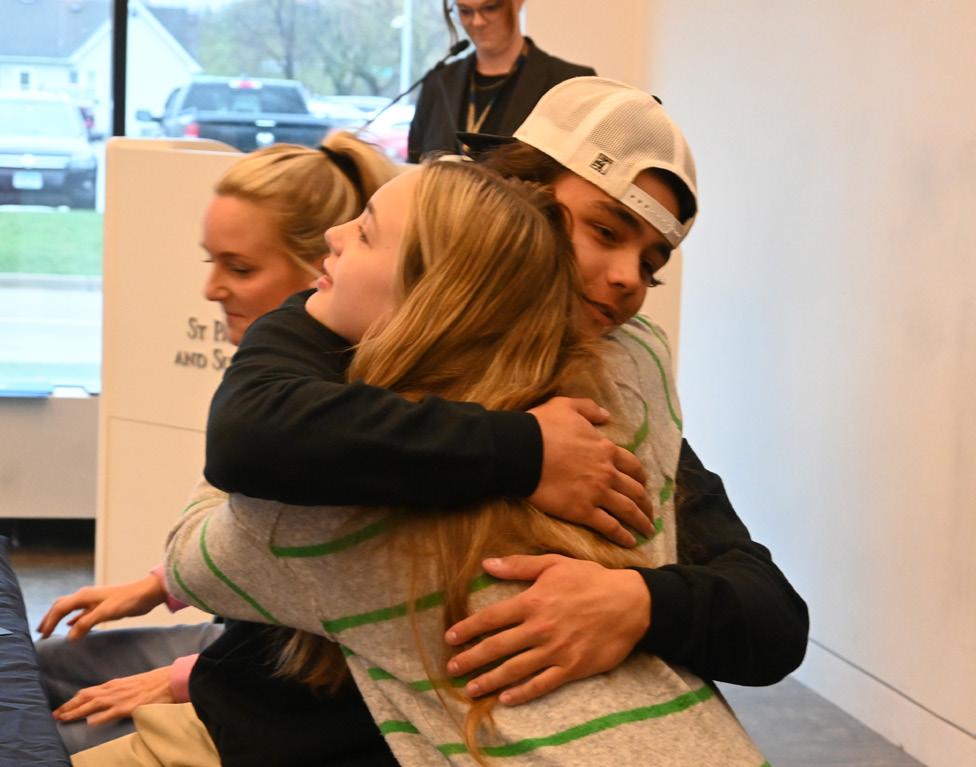
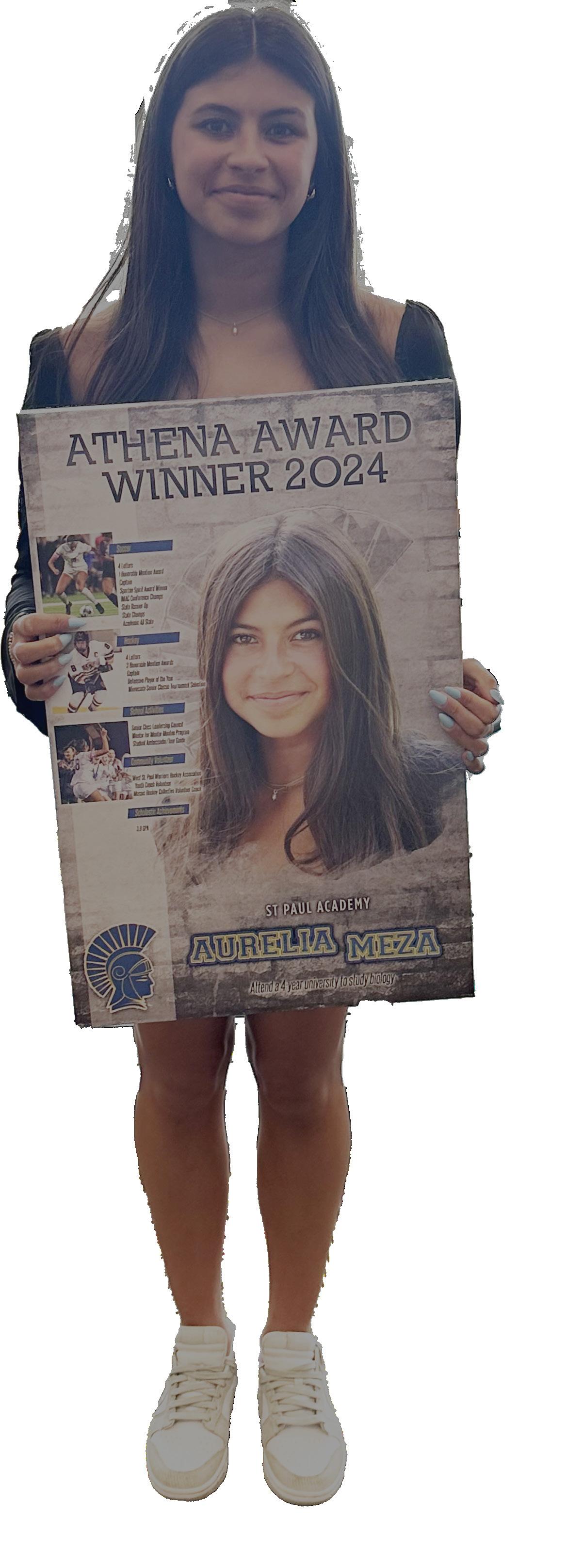
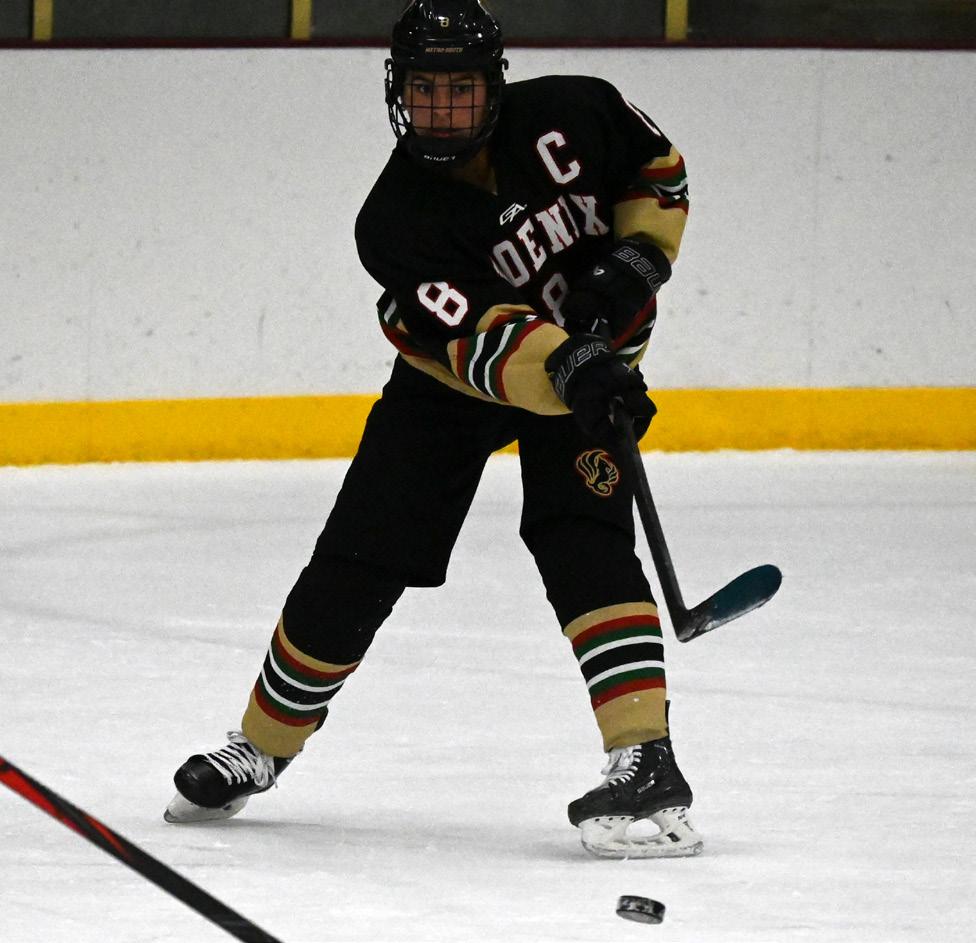
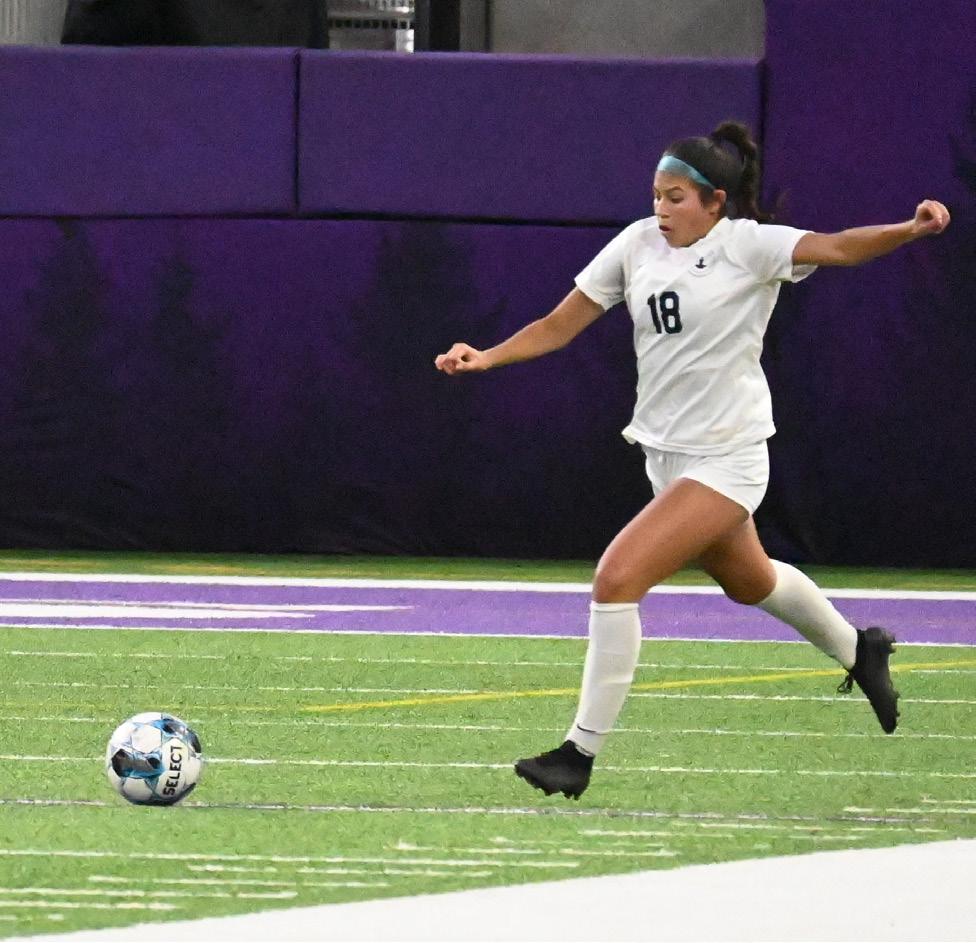
Soccer state champion and hockey captain senior Aurelia Meza was bestowed the school’s Athena Award earlier this month. The award is granted to a senior female athlete who has “distinguished herself in special individual athletic achievement or superior achievements in one or more sports.” The athlete is selected by her individual school independently from the Athena Awards Committee.
“I was honestly very shocked that I got it,” Meza said. But her achievements are ample evidence of her Athena
spirit. She has participated on the varsity squad for hockey and soccer all four years of her high school career. Was an aggressive defender on the Phoenix hockey team and led her soccer team to state finals twice as the starting defender and took home the championship this year. “I am very proud of myself and my accomplishments,” Meza said.
Outside of her accomplishments during games, as a teammate, she has the same positive impact in and out of the season. Soccer teammate Lucia Gonzalez looks up to Meza as a role model for the passion and ded-
ication she puts into the game.
“She is so hardworking and encouraging and you can tell she loves whatever sport she’s playing and all of her teammates,” Gonzalez said.
When it comes to her recognition of this award, she hopes people can look past just her athletic success to the broader issue.
“I think it’s important for people to see athletes of color succeed and continue to play sports, especially for younger generations,” Meza said.
She hopes that her demonstrations of atheism will encourage other athletes of color to con-
tinue striving for success in their sports. When looking at the data, it can be seen that role models like Meza are necessary.
Across the National Collegiate Athletic Association’s three divisions, only 32% of the athletes were athletes of color in 2021-2, the highest percentages being in basketball and track. The lowest is in one of Meza’s sports ice hockey. Meza’s success in her sports continues to fuel other athletes’ passion and perseverance.
“I hope that I show that athletes of color can continue to play sports and that you will matter and have an impact,” Meza said.
Freshman Langston Thompson was ecstatic when he learned he would compete this winter on the same SPA basketball team as his brother, junior Oliver Thompson.
For Langston, growing up and practicing the same sports as his older brother Oliver was just another way to spend time with him. From soccer to basketball to track, both Thompson’s competed together, even at their elementary school, Yinghua Academy. This year, being on the same team again promised more fun and unforgettable memories.
Both brothers share perspectives on how their different sports are played, which allows them to understand and communicate their thoughts easily.
“I feel like I can be more open with him … I don’t have to be as eloquent to ask him something or tell him something,” Oliver said.
WE
PUSH EACH OTHER A LOT TO GET BETTER ... IT’S REALLY BENEFICIAL. “
junior Oliver Thompson

Friendly competition between the brothers has also helped them continue to improve.
“There’s an air of competitiveness, I can’t have my little brother beating me after all,” Oliver said.
Their time together as teammates and rivals has forged a stronger bond on and off the field.
Oliver’s experience mentoring Langston has also helped him in his role as a captain of the track team this year.
“I give him more direction than other people … I have honestly higher expectations [because] I want him to succeed badly and I know what he is capable of,” Oliver said.
“We both push each other a lot to get better … I think it’s really beneficial,” Langston agreed.
Outside of regular practices, the brothers sometimes shoot a couple of baskets outside or compete in how much weight they can lift at the gym.
Both brothers have many hopes and dreams for the upcoming track season. As a captain, Oliver’s goal is to hopefully make it to state this year and continue building the Track and Field team.
“I think a big part of
[my goal] is getting my brother and, in general, more younger people involved,” Oliver said.
Langston has similar goals for track. “[I] also want to make it to state at some point in high school,” Langston said. He also adds some future goals for basketball.
“I want to dunk the ball … at least before [my brother] gets it.”
Oliver and Langston hope to continue improving their individual skills through perseverance, passion, and most importantly the support of their brother. Their next meet is May 7 at The Blake School at 4:15.


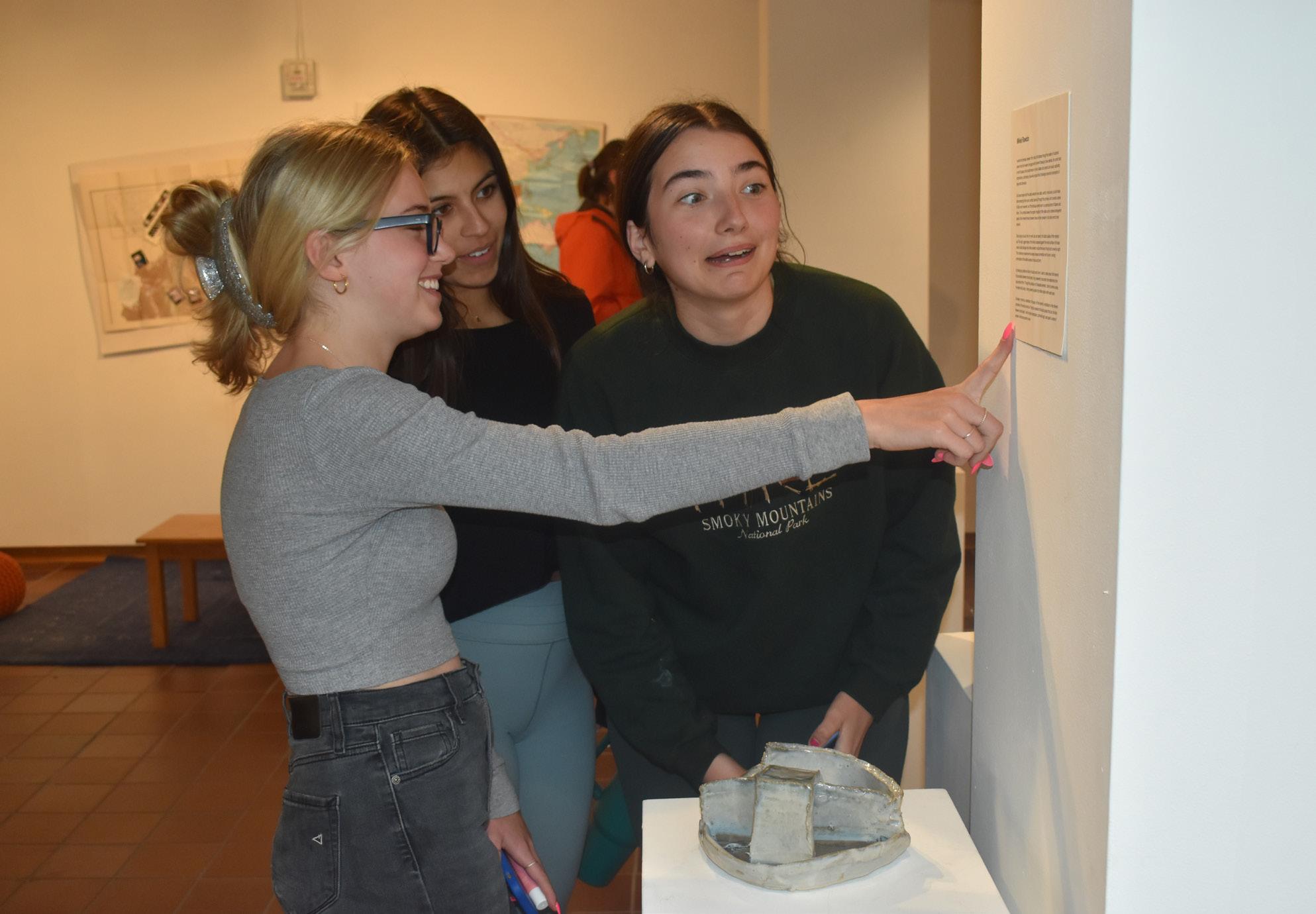
1.


a
February 29,
The feeling of the male gaze, a childhood memory, facing the world during burnout. Themes based on artists’ personal experiences all fall under the common theme of “People Watching.”
On Apr 8. senior seminar artists displayed their work in the Drake Gallery for the final time as high school students. The 14 seniors represented the theme of people watching through use of ceramic, photography, paint, video, or mixed media. During the X-period reception, many peers and teachers came to support the artists and take a peek into their work.
Finding a theme was difficult for the seniors as their work pulls from personal experiences and unique perspectives. 2D artist Violet Benson painted four memories from her childhood in acrylic and watercolor.
“My work doesn’t completely play into the theme, however, I painted people … and people will be looking at those people” she said.
For others, the theme came more naturally. Fellow 2D artist Bri Rucker created three pieces with varying mediums.
They created a stained glass window depicting a skeleton in the Garden of Eden, a painting of dead flowers, and a plaster cake of bones. The flowers they described in their artist statement as a representation of facing the public while experiencing burnout and the cake was simply a last hurrah creative desire.
named Humphrey, wears thrifted baby clothes, a ceramic brain and wire angel and devil on each shoulder. Kimmel reasoning for this sculpture was similar to Rucker’s cake: she wanted to make it and thought it looked cool.
“ senior Clare Kimmel
LAST YEAR MOST OF MY SCULPTURES WERE CERAMIC SO FIRST SEMESTER, THIS YEAR, I ONLY FOCUSED
ON WIRE.
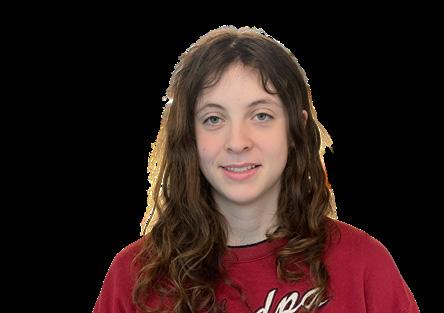
“[These pieces are] a commentary on how what you do matters and knowing that you can look back on choices you made,” Rucker said.
As this was the last show for many, their work served as a culminating experience. Sculptor Clare Kimmel created a clothed stick person. The sculpture,
“Last year most of my sculptures were ceramic so first semester, this year, I only focused on wire. This semester I wanted to bring everything together,” Kimmel said.
The exhibit marks the end of their work on projects: “It’s a little scary [being my last show] but I have loved what I made,” Rucker said.
Benson agreed with the bittersweet feeling of the closing ceremony.
“It is strange that [it is] my last high school show,” Benson said.
The artists’ work concludes up to four years of art study and reflects some of the best of their abilities. The seniors’ art was displayed in the Drake gallery until Apr. 26.
“Genres are a funny little concept, aren’t they?”
This is the opening line to the song “SPAGHETTII” from Beyoncé’s latest album, an exploration of the country genre titled “Cowboy Carter.” Linda Martell, the first commercially successful Black female artist in country music, begins the track with this question that hints at the racialized labels placed on different musical genres.
The country music genre has long been filled with white singers, but with “Cowboy Carter,” Beyoncé has proven that her music doesn’t fit into one box or the other.
Senior Millicent Benson, a longtime Beyoncé fan, said, “I think she’s kind of just showing that people can make music in any genre, really… I personally wouldn’t listen to [the album] again, but I still think it’s cool that she’s trying something new.”
The decision to explore country music originated from Beyoncé’s experiences of discomfort and exclusion. She explained in an Instagram post announcing the release of “Cowboy Carter,” “It was born out of an experience that I had years ago where I did not feel welcomed…and it was very clear that I wasn’t. But, because of that experience, I did a deeper dive into the history of coun-
try music and studied our rich musical archive.”
A study conducted by Dr. Jada E. Watson, Assistant Professor of Digital Humanities at the University of Ottawa, demonstrates how little people of color are represented in the country genre. From 2014 to 2020, an average of 3.7% of the songs played on country radio stations were by artists of color.
Beyoncé’s new album is a step in the right direction toward increasing the diversity of country music artists. One single released before the album dropped on March 29, “Texas Hold ‘Em,” debuted at number one on Billboard’s Hot Country Songs chart. Beyoncé is the only Black woman to
accomplish this, paving the way for future Black country singers. However, she isn’t the only Black country artist worth celebrating. Despite the genre’s racist and exclusive past, countless Black artists broke into the country scene before Beyoncé and continue to do so today. She thoughtfully features them on “Cowboy Carter,” collaborating with Martell, Willie Jones, Shaboozey and more.
“Cowboy Carter” has received mixed reviews so far and certainly has some critics. Senior Delaney Devine said, “I feel like [Beyoncé] changed [her genre] to fit in with what she thinks is popular right now, and I don’t think she necessar-

ily needed to do that because everyone loved her current genre.”
Love or hate the album, one thing remains clear: Beyoncé is making waves in the country music world by bringing racial diversity and a fresh voice to the white-dominated genre.
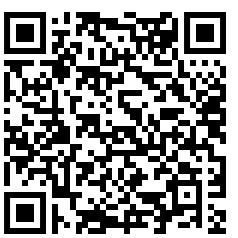
For three years, one tradition has brought a unique aspect to the orchestra: senior picks. While every song that the orchestra performs is chosen by its members, this rite of passage allows seniors to end their orchestra career with one special song that only they add to the setlist.
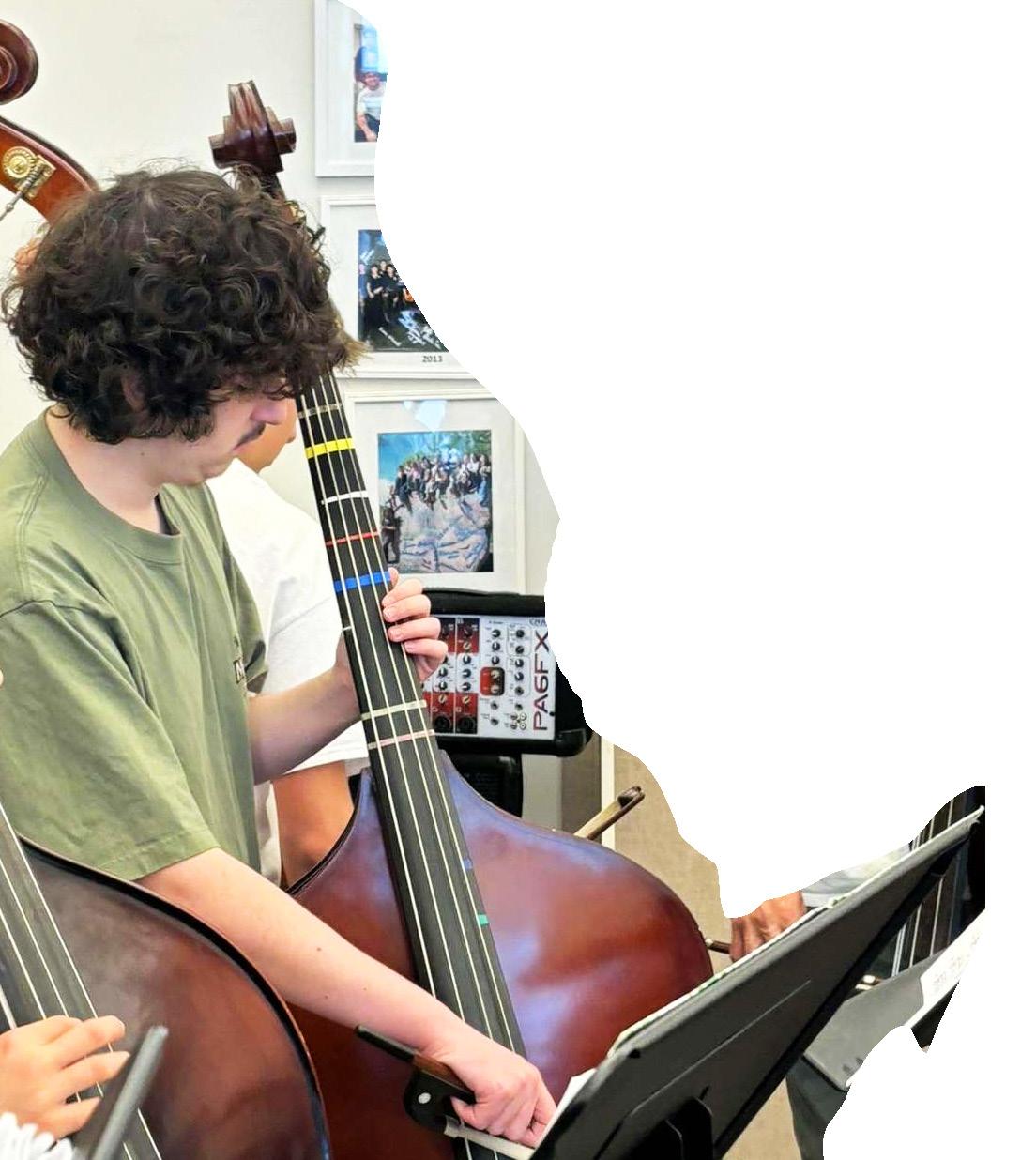
“We found that every year there’s a song that the seniors request, ‘Can we play that again?’ … There’s so much music, so little time, so [I said] let’s not play pieces that you’ve already played before,” Director of Orchestras Almut Engelhardt said.
To deal with this complaint, when the class of 2022 suggested adding one song of the seniors’ choosing, Engelhardt agreed.
That class’s pick was “Pirates of the Caribbean,” and last year, the seniors selected “Irish Party.” This year’s choice, “Howl’s Moving Castle,”
has been a popular recommendation for a few years, but was not performed for various reasons.
“I suggested it last semester, and we decided that we had other songs that would fit the pop concert aesthetic more,” senior Maik Nguyen said. Instead, “Howl’s Moving Castle” was suggested as the senior pick for the spring classical concert, and when the seniors agreed that they still wanted that song, it was incorporated into the repertoire.
“Howl’s Moving Castle” was featured in the 2004 Japanese animated film of the same name; all of the music in this film was composed and conducted by Joe Hiashashi. While “Howl’s Moving Castle” has been a frequent song request, there wasn’t a score that would work for an orchestra until this year.
“It [has been] suggested so many times, and so there was really no reason not to play it this time because we have


music finally,” Engelhardt said.
Both Nguyen and senior Oliver Zhu love the song and the movie it was featured in.
I REALLY VALUE HAVING THE EXPERIENCE OF... BEING PART OF SOMETHING GREATER. “
senior Oliver Zhu
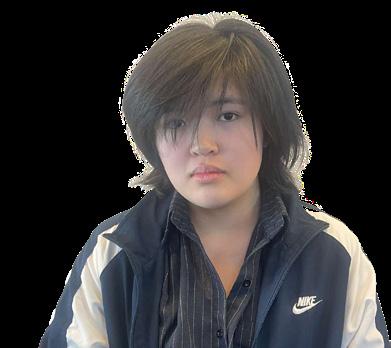
“If we’d played any of [the composer’s] songs in orchestra, it would be great,” Zhu said.
Nguyen appreciates how the song uses many instruments, fitting for the multi-instrument orchestra.
Similarly, Zhu likes this arrangement in particular, “because it’s less strings-heavy … there’s no melody in the strings.”
Engelhardt sees “Howl’s Moving Castle”
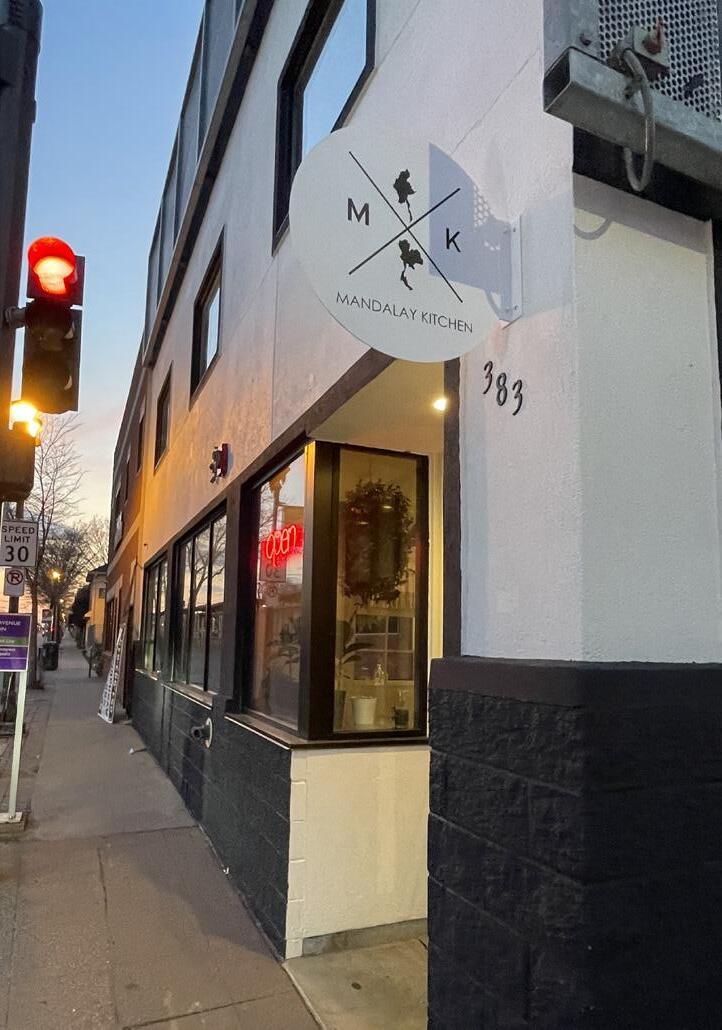
as the perfect sending-off song for the seniors: “I like that it’s so bittersweet … I’m sure everybody’s glad to move on, but at the same time, it’s also the end of a chapter that’s not coming back,” she said.
As a contemporary waltz, Engelhardt explained, “It’s different from the other pieces we play but it’s not out of place.”
Nguyen and Zhu expressed these simultaneous feelings of accomplishment and sadness. “I really value having the experience of … being a part of something greater, making this huge piece of music that would be impossible, if every single person [was not] doing their best,” Zhu said.
Both played in the orchestra for the entirety of high school, and Nguyen began learning in sixth grade. “I’m very happy that I stuck [with orchestra] throughout … my four years,” Nguyen said.
The orchestra and choirs performed in the Huss Apr. 27 at 7 p.m.

ORION
KIM co-EDITOR IN CHIEFOn Nov. 13, I went to Mandalay Kitchen, a new restaurant that opened just last November. The kitchen is named after the city of Mandalay located in Burma, which fuses many different cultures and food origins. The Head Chef Chris Tunbaw hoped to share his passion for bringing people together through food by serving a variety of Knyaw, Burmese, and Thai Cuisine.
The restaurant is located on University Avenue in St. Paul. Although I ar-
rived later in the night when the staff was cleaning up and the majority of customers had departed, the waitstaff was incredibly warm and welcoming.
A server came almost immediately and walked over to suggest drinks, and I ended up ordering the basil lemonade. Overall, the drink was refreshing but it could have used stronger hints of herb.
The waitstaff returned quickly to take appetizer orders. I ordered the Fried Chicken Wings, which were deepfried and smothered in laab dry rub. It came with six pieces, all lying on a bed of red cabbage, onions, basil, parsley,
and scallions. The flavor was impeccable and the crunch was perfectly crispy.
For the main dish, I requested the Thai Red Curry. The curry itself was made out of spicy red paste and coconut milk, which was rich with cream and flavor. The bowl was loaded with Thai eggplant, rainbow assorted bell peppers, potatoes, basil, kaffir leaf, and krachai, and a side of white rice.
Although the curry was satisfactory, it could’ve used stronger flavors other than the curry itself. The vegetables and chicken that were added to the dish would benefit from heavier seasoning.
Overall, the dining experience was thoroughly enjoyable. Throughout the night I had multiple waiters rather than one designated server. They were all very accommodating of allergies if that’s a major source of concern. As I left Mandalay, the head chef came out to personally thank us, which spoke to the hospitable and personal nature of the restaurant.
RATING: 4.5/5
16 THE RUBICON - APRIL
Rivers builds community homes by volunteering with Habitat for Humanity
HSUStressful and coincidental. These two words aren’t usually used to describe senior projects; however, they perfectly encapsulate Senior Ayla Rivers’ experience leading up to her final decision to work with Habitat for Humanity.
Initially inspired by a passion for art, Rivers wanted to work with the parent of a SPA alum on a project related to glass-blowing; however, due to conflict issues, the idea fell through. Rivers’ second idea was to help a few bike shops assemble bikes, even reaching out to five different shops to no avail. Feeling pressured, Rivers started reaching out to stores randomly, hoping for a response. “At this point, because I was getting pretty stressed about not having a project,” Rivers said.
Continuing to brainstorm ideas, Rivers sat down with her family one day, and someone suggested looking into Habitat for Humanity, a global non-profit with the goal of providing everyone with an accessible and affordable place to live.
Having figured out her shift schedule and awaiting supervisor approval, Rivers is set to begin working on April 29th. She will be volunteering to build houses alongside the organization.
icies and systems. For example, Cost of Home, their most impactful U.S. advocacy campaign, has improved access to affordable housing for over 6.6 million people.
“I knew that from the beginning of my project I wanted to do something with my hands, and building houses for a month with Habitat for Humanity just … worked out, “ Rivers said. She hopes that pairing with the organization to construct housing structures will have a positive impact. “My end goal is to be proud of the work I put in
2023 SENIOR PROJECTS BY THE NUMBERS
12 hours of service required for all seniors over the course of senior projects
Leatham protects and researches Caribbean birds with Bonaire Wild Bird Rehab
GEORGIA ROSS CHIEF VISUAL EDITOR7 senior projects focused on service and volunteering
97 total senior projects in 2023
8
senior projects based on early childhood education
BECAUSE OF MODERN INFRASTRUCTURE AND THE IMPACTS OF CLIMATE CHANGE, IT’S IMPORTANT TO BE DOING THIS WORK NOW. “
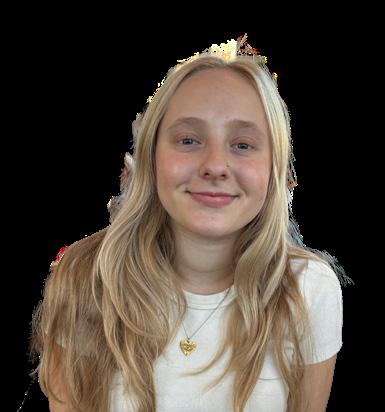
to reserve and restore the native species,” she said.
After 2 weeks at the Roseville Nature Reserve, Leatham and project groupmate Clara McKoy will continue their volunteering in the Caribbean. The organization they will work with aims to provide the best possible care to injured, sick and orphaned wild birds and to release. Leatham describes the environment as “sunny … and … the most blue water you’ve ever seen,” she said.
“ senior Ayla Rivers
I KNEW ... FROM THE BEGINNING OF MY PROJECT I WANTED TO DO SOMETHING WITH MY HANDS.

Working with over 70 countries and impacting around 59 million lives since 1976, Habitat for Humanity places importance on building a safe and healthy community centered around people. Partnering with different local organizations, they offer many services such as home construction, support for elderly homeowners, revitalizing neighborhoods, financial education, disaster response, and research into home innovation.
Outside of these services, Habitat for Humanity is also heavily involved in advocacy for more affordable housing and breaking racial barriers in homeownership through campaigns to change pol-
19.6% of senior projects related to art and creating personal projects
21.6% of senior projects learning about business, marketing, and finance
INFORMATION: Data reported by the Class of 2023 in April 2023
and what it created … and to also know that what I helped build will hopefully better someone else’s life,” Rivers said. Rivers is excited to immerse herself in the new experiences that come along with her project: “The point of a senior project is to acquire an internship or apprenticeship position, learn a new skill or trait, but most importantly explore an area of interest of yours.”
To get involved with Habitat for Humanity, the organization offers many volunteer opportunities on its website, from working locally or abroad to low-commitment or long-term options to sign up for. Support through donations will also help the non-profit expand and provide resources to help more people.
Family time, friend time, beach time, and service time are all boxes that senior Audrey Leatham’s senior project checks. Leatham’s project will be split into two activities in two different environments: she’ll start off May working at Harriet Alexander Nature Reserve in Roseville, Minnesota, trailblazing and working with younger kids to explore the forest. But by the end of May, she’ll be in the Caribbean with Bonaire Wild Bird Rehab, working on bird rehabilitation and making wildlife information accessible to the public.
In the forest, Leatham’s work will be geared towards trial restoration and providing younger children with immersive learning experiences in a natural environment. After the winter months, the trials lose their defined paths. Leatham will clear debris, mark the trails, and identify plants to display in the nature center. In an effort to get younger children involved and learning about the wildlife around them, Leatham will explain to kindergarten-aged touring groups the inhabited plants and animals on and off the trail.
Leatham explains the organization’s work to “educate younger people about how to get into nature … make that a habit … promote healthy living … and
From recording data, to rescuing, to posting on social media, Leatham will be involved with a variety steps of the birds’ recovery process. On days outside of the center, she’ll observe birds in their natural environment, log and photograph the ones that nest and their habits, and bring injured birds back to the main center. On days inside the center, she’ll feed and heal the injured birds, and manage the online medias. Leatham’s work will conclude with a final presentation to the Board of her photography and information she collected. She hopes to help the organization receive more funding to aid the birds struggling from increased urbanization and pollution.
“Because of modern infrastructure and the impacts of climate change, it’s important to be doing this work now,” she said.
Leatham is excited to explore, restore, and interact with the environment in a more meaningful way. She looks forward to “exploring different parts of the island … getting more familiar with the island in an independent way … and meeting new people,” she said.
Habitat for Humanity is a nonprofit organization working to build affordable housing for low-income and underserved families. The organization is active in more than 70 countries and offers a variety of services including home construction, financial education for homeowners, disaster response, and neighborhood revitalization. Volunteers can find their local Habitat and get involved with building, outreach and more.
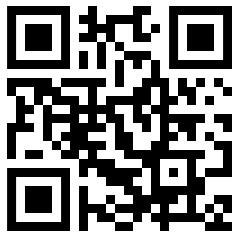
mission.
Bonaire Wild Bird Rehab is a nonprofit organization formed in 2018 under the Mangrove Info Center, which was founded in 2002 to offer eco-friendly mangrove tours for visitors of Bonaire in the Caribbean. The rehab center works to help the island’s sick or injured birds, including Bonaire’s national bird: the American Flamingo. While the rehab center generally doesn’t allow visitors, the organization accepts donations.
